No products in the cart.
Uncategorized
Hershey 2021
Preparations started months—years—before, of course.
There were discussions with local government and corporations, evening phone calls, maps and diagrams, disagreements, more phone calls. Retired club members worked out the plan with busy younger members—who later enlisted even younger volunteers to help with the grunt work, as well. Thousands of theoretical little two-dimensional squares on paper were numbered, and—much later—became actual self-adhesive stickers with those same numbers and now names reflected. As the weeks passed away, concerns turned finally to the weather forecast. It’s almost here … !
All this leads, annually and ultimately, to the in-the-flesh, feet-on-the-macadam Fall Hershey Meet, the largest gathering of antique car enthusiasts in the world. On the north side of the small town known throughout the world for chocolate, tens of thousands of auto mechanics, enthusiasts, sons & daughters of mechanics and enthusiasts, opportunists, campers, old friends, business owners, historians, car lovers, and the casually interested gather this time of year … to do … what they do. They walk the miles of rows, drinking too much coffee, eating the wonderful salt- & vinegar-slathered french-fries, looking for good deals, imagining possibilities, and dealing with sore legs and feet. For a few hours to several days, these faithful forget responsibilities, illness, sadness, and the occasional darkness of that other world, and lose themselves in this here-and-gone world of old stuff. They come from miles, and continents away. It’s good to be back.
My preparation begins mostly the night before, fortunately. (Well—that’s aside from helping the hard-working Hershey Region members lay out the fields, back in September. While invisible to 95% of the walking masses, a reality is that every one of the thousands of little notional spaces—that become 10×20 foot real spaces—need to be measured and marked out each year. Showing up to an empty parking field on an evening after work or early on Saturday, weeks in advance of the actual event while the summer vacationers are still shrieking on the nearby park roller-coaster, volunteers fondle a Dunkin Donut and then move out in teams to place small white stickers on the ground. After five or so years, I’m actually getting pretty good at it, and this year only had to remove an entire miss-numbered row once…or twice.)

But, that was weeks ago. Jumping to the night-before preparations, these are mine: Clothing is laid-out, based upon the weather. Running (now walking, at this age) shoes. From downstairs, I collect my back-pack off the hook—the same one I carried around Iraq, fifteen years ago, with “RUSSELL” and naval aviator wings sewn on (I still have yet to have anyone approach me and say “Hey, were you…?”). Into the pack are checked: hat, wet-wipes (in my opinion, the best thing since, yes—sliced bread), sunglasses, a baggie of Ibuprofen and Tylenol pills, water, and some preparatory snacks (being either frugal or just plain cheap). That’s what I’ll need. What none of us Hershey walkers need are the usual daily concerns; have a glass of wine tonight and think happy thoughts about the morrow. Then it’s early to bed; Hershey requires your best.
If you couldn’t make it to Hershey, I hope you’ll enjoy my reporting, and imagine this being your own adventure!
Cars and old cars
Hershey is primarily, we realize, an old car event. Thus, old cars—and, actually to a great degree in the vendor fields, where I’ll be taking you, the parts that allow old cars to keep going—are the most common ingredient at Fall Hershey. Cars for sale are interspersed with their owners on the vendor fields and along the perimeter of the Orange and Green fields; called the “Car Corral.”
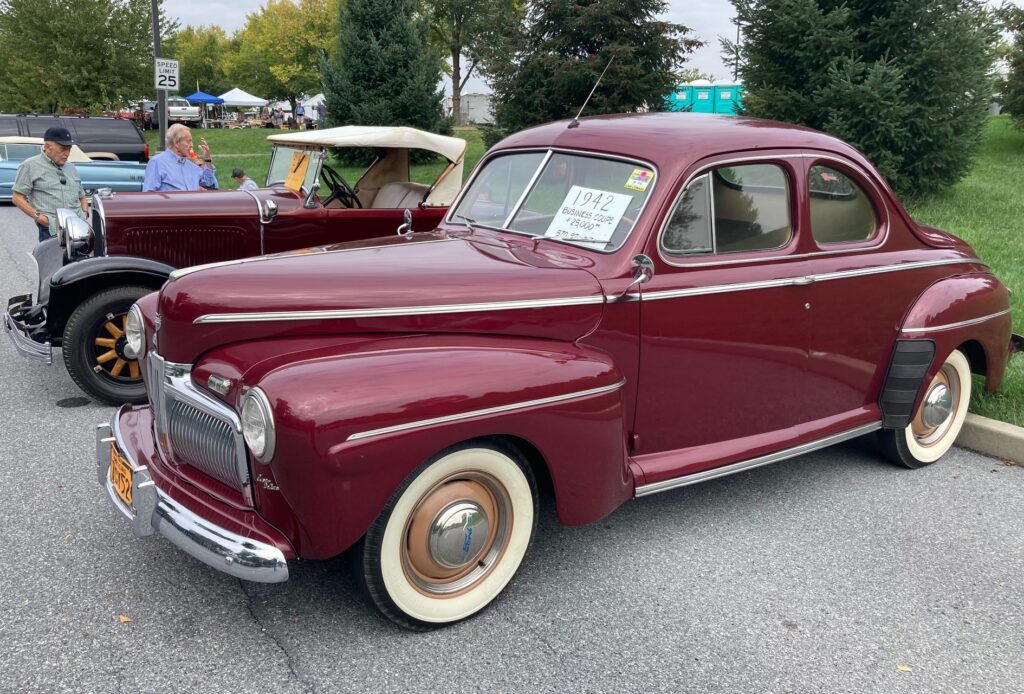
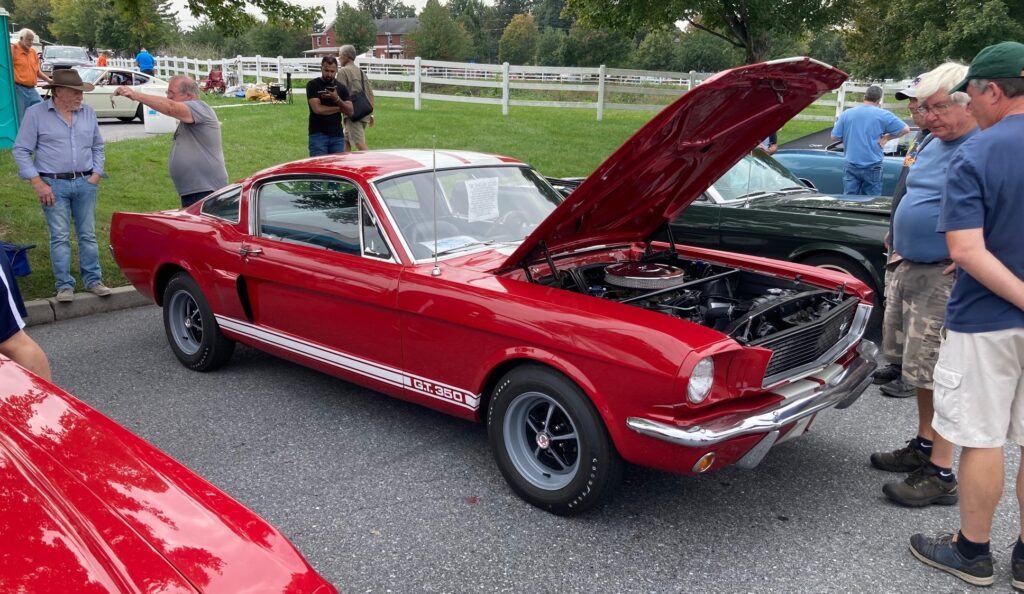
Hundreds of cars are brought for sale. From humble conveyances made in the 40s to the sexiest hot collector cars, like this Shelby 2+2 (top). What always amazes me is that for one half or one third the cost of the least expensive new car, you can drive off in a restored or preserved antique. Yes, for $8K to $12K, you can purchase a good, running car—made so that non-scientists can still work on it—and drive it off the lot and enjoy it! That, to me, is incredible. (Yes, notaries are standing by.)

Who knew Subaru made a sub-compact? This seller says he has five of them! The red car on the left of the Subaru is a BMW Isetta—now in the ‘collector’ price range. $25-30K would buy you a nice one…though it’s essentially too under-powered to be drivable in traffic.
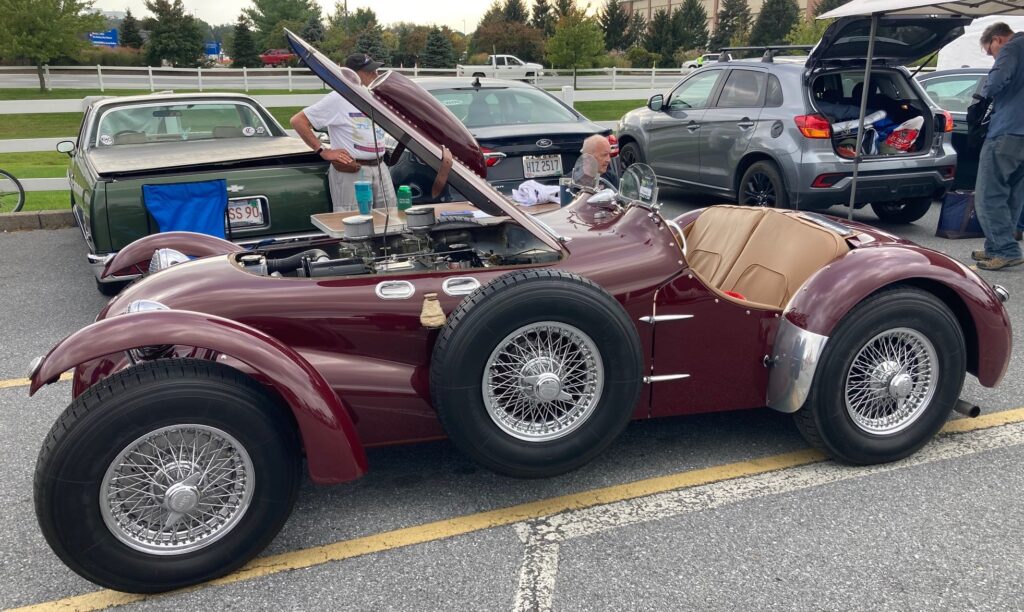
I didn’t even catch what this thing was. But, it’s beautiful. The driver of this car isn’t going to feel boring.
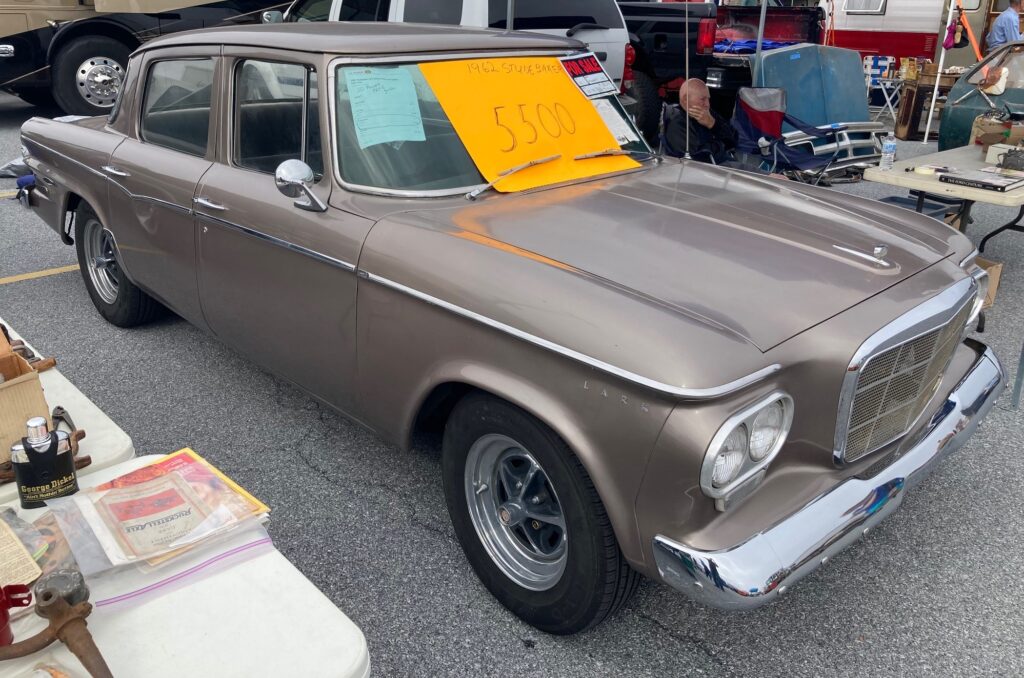
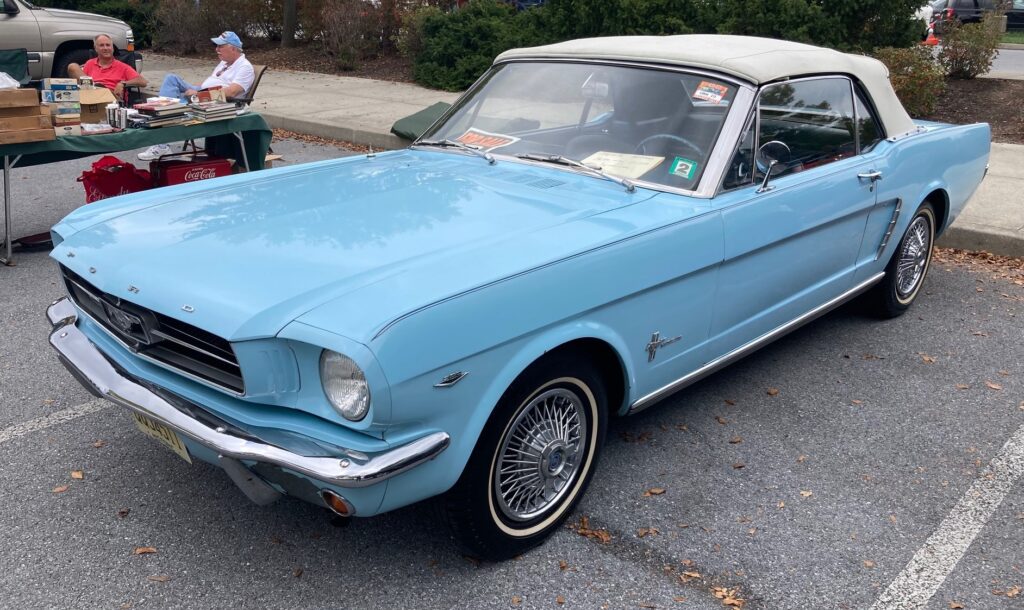
But, let’s get back to my ‘affordable’ premise. The Studebaker Lark was being sold by a father, for his son. $5500 for a classic with good paint, a V8, nice aftermarket wheels, and a reasonable interior! The baby-blue ’66 Mustang is another bargain: $25K (asking—you know they’ll take less) gets you an exercise in automotive design perfection, ready to drive to work or show, with a convertible top and a reasonable six-cylinder engine. Beyond that, it will not depreciate. Can we say that for our current SUVs?
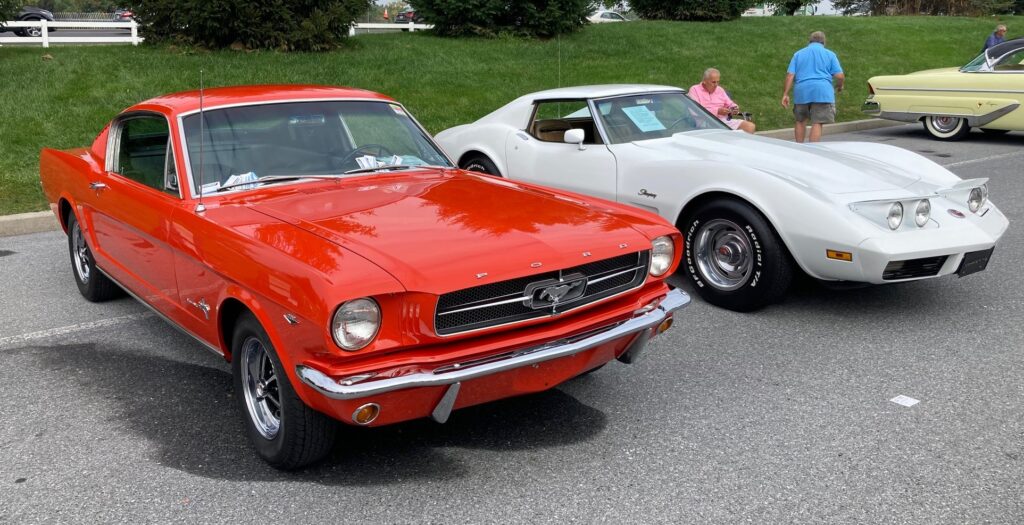
Do you need a bit more sportiness? The ’66 Mustang V8 will be priced a bit higher, demanding about $32K these days for a good one—but still less than your minivan. The white 70s Corvette remains the sports car bargain. $10-15K will still bring you home a very nice driver that will never look bad in your garage—and will only grow in value. Reproduction parts are available and reasonably priced. (And for a few hundred bucks you can probably fix the non-retracting retractable headlights on this example.)
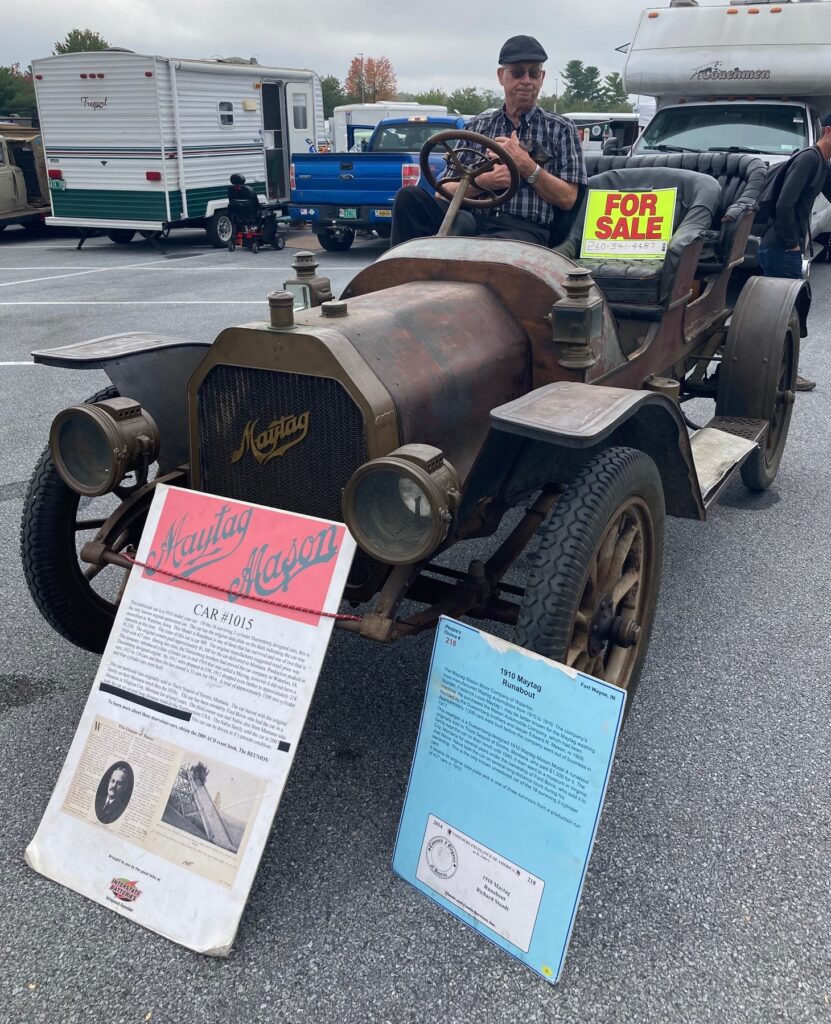
But, remember that Hershey is about all old cars—not just muscle cars for boomers. This 1920 Maytag (yes—the washing machine people) was started regularly by its owner at the show, and is apparently ready for a new caretaker. This machine is in a “preservation” status, a welcome alternative to the traditional “must-be-restored” (over-restored?) philosophy of the old car hobby. I believe the asking price was less than $20K. For a 101-year old running car!
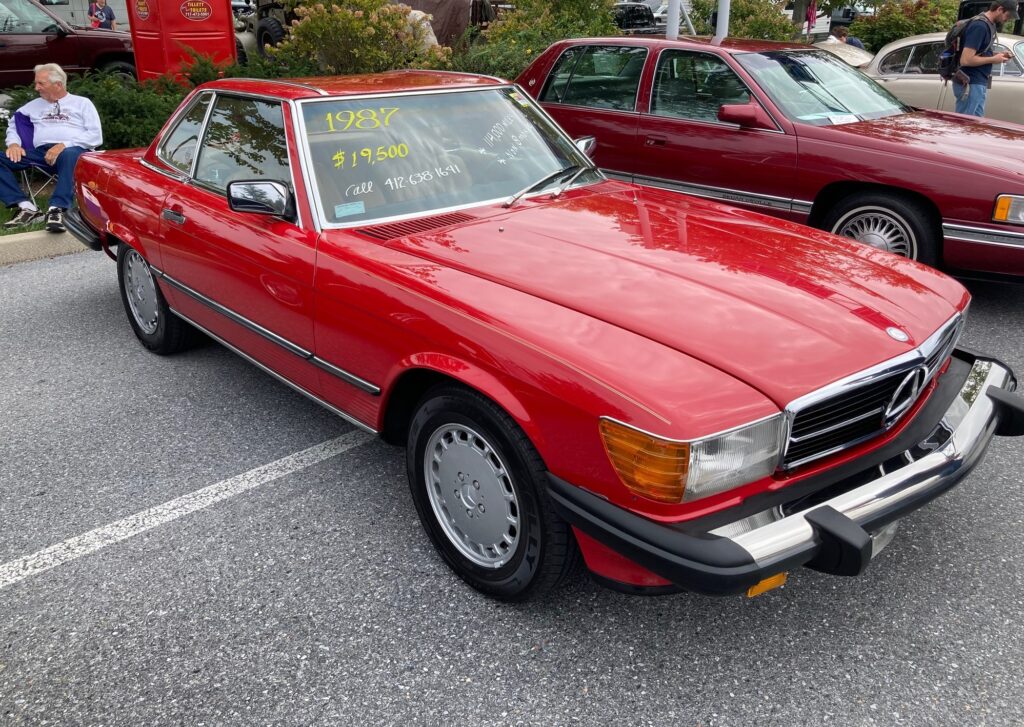
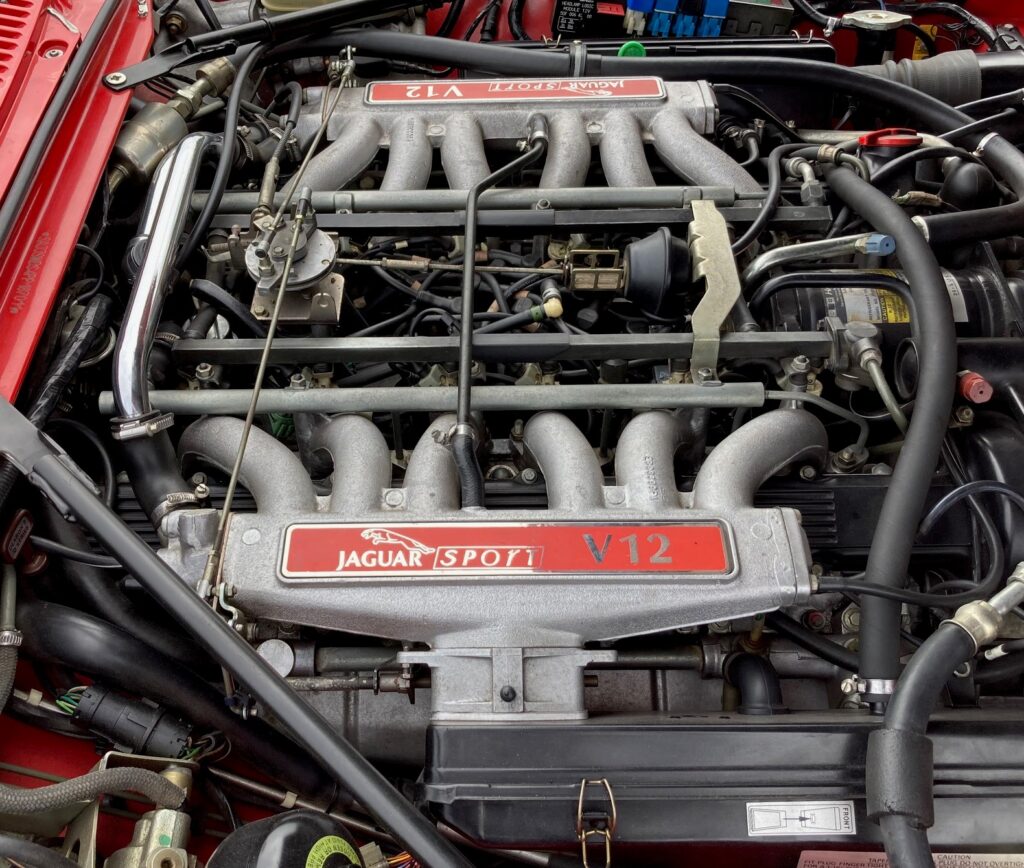
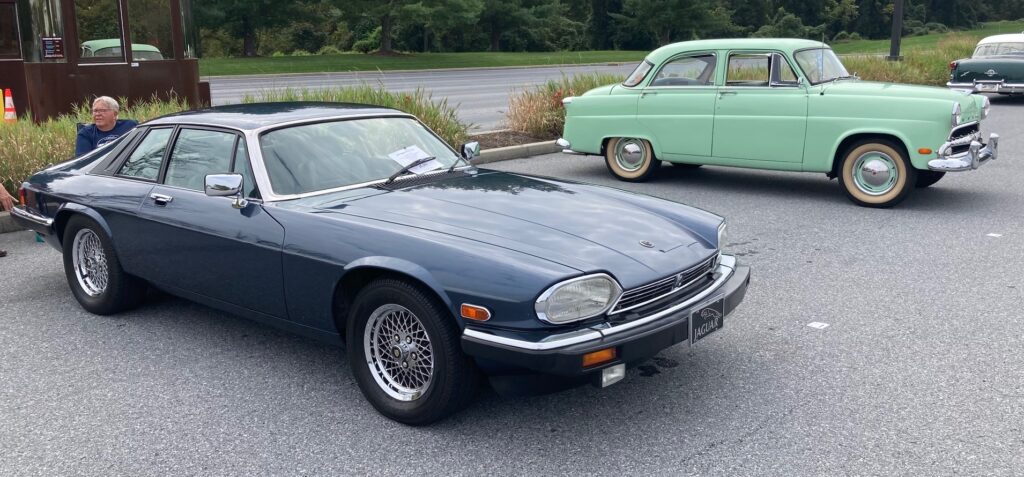
Automotive writer, historian and enthusiast Steven Rossi recently reminded readers that “there’s nothing more expensive than a cheap Rolls-Royce…or Ferrari…or Mercedes-Benz…” There are plenty of used exotics for sale. But beware of one’s auto dreams.
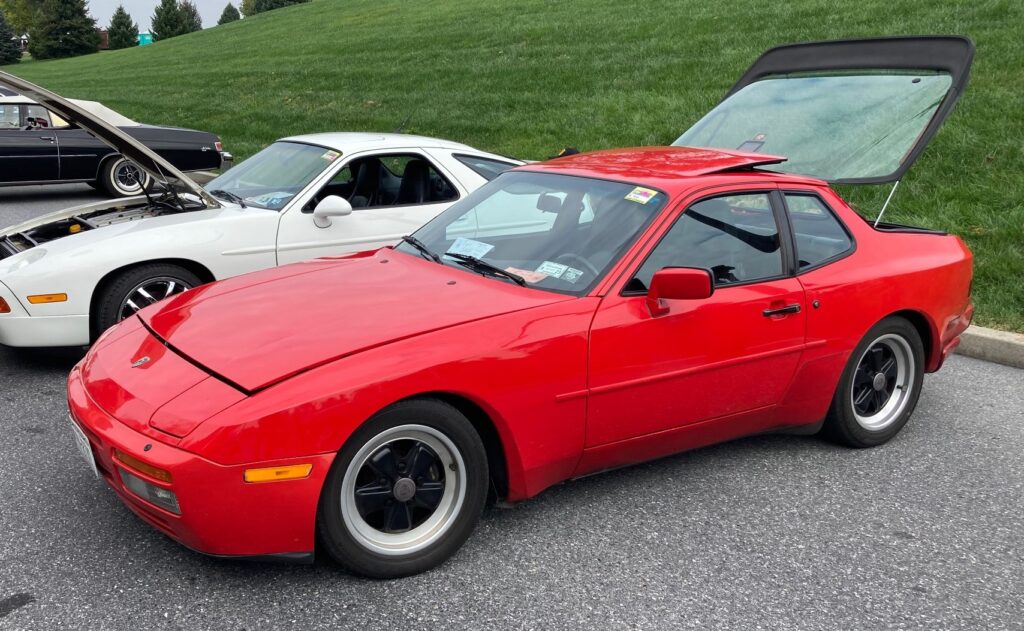
Having said that … here’s a Porsche 944. And, it’s red! Wow, that’s nice! Seems simple enough … and he’s only asking $XXXXX. I mean, what could go wrong?
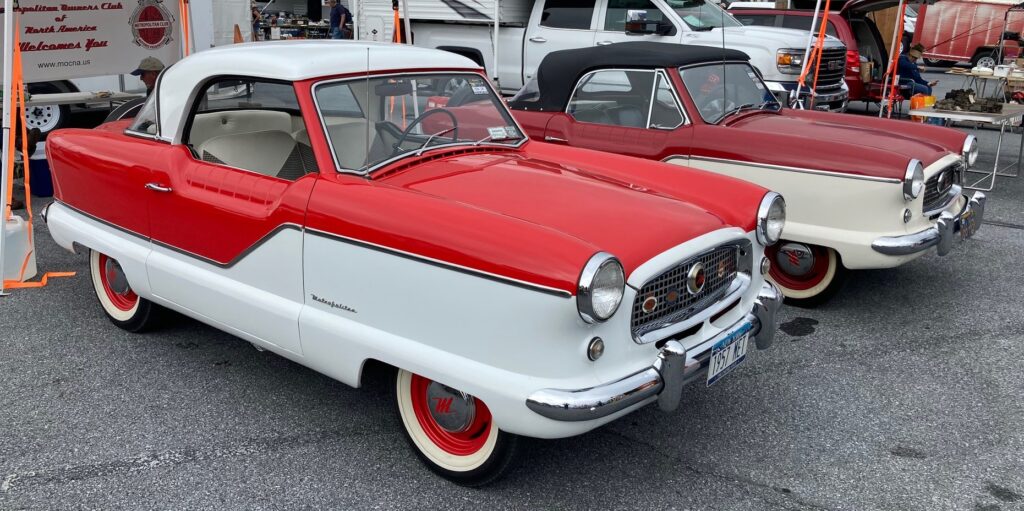
More really good deals … who could not love one of these AMC-marketed Metropolitans? These are the automotive equivalent of baby bunnies and kittens—they pulsate cuteness. Around $15K gets you a perfect one, ready to commute you in outrageous, reasonably reliable 1950s style.
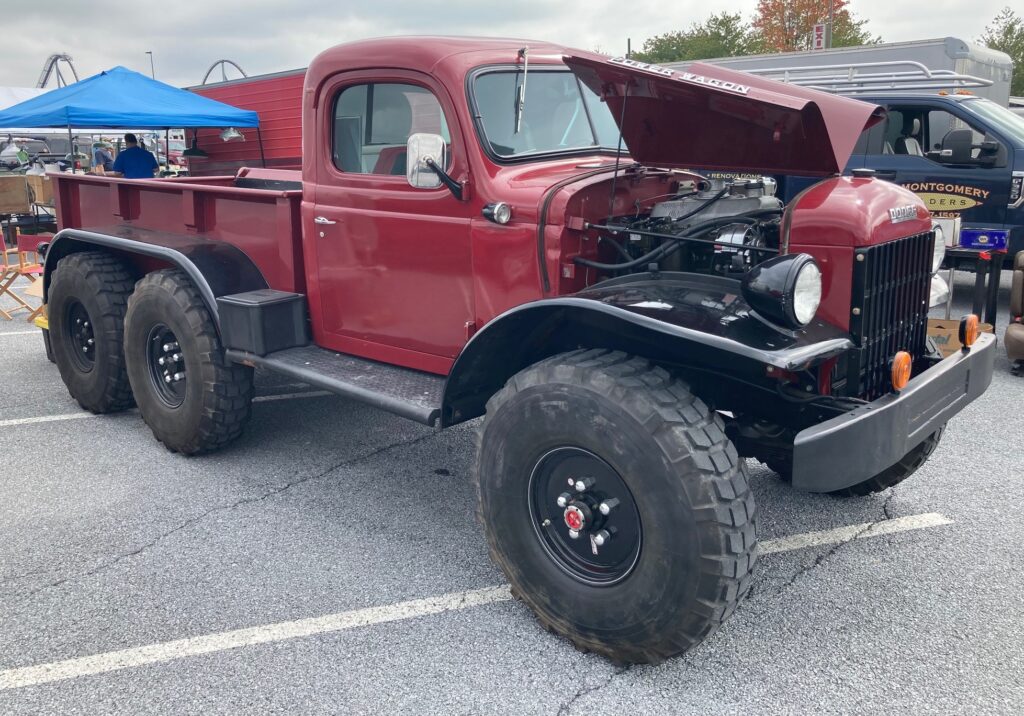
Then, there are trucks. Big trucks—fire trucks, commercial trucks, busses. All these are collected by their own sub-culture of fans. This six-wheel-drive Dodge Power Wagon could certainly plow your driveway.
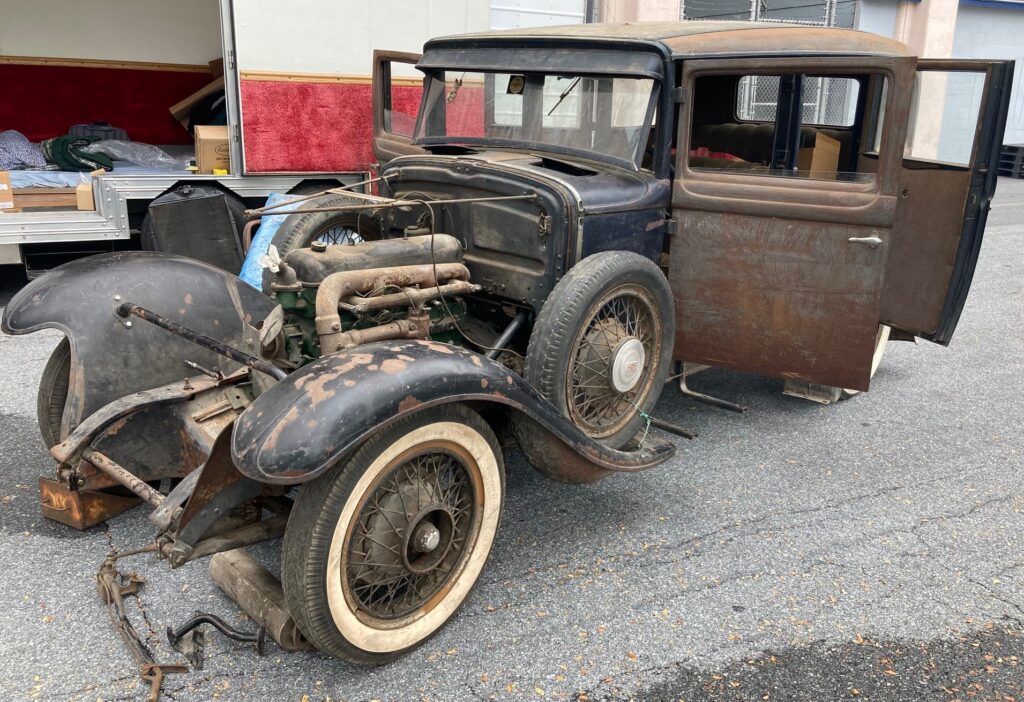
Still, the root of the old car hobby remains with the idea of taking an old car and restoring it; making it good and useful and beautiful again. Here is a story and a starting place for someone not afraid of time, expense and a challenge—and with a dream!
Motorbikes
Motorcycles, scooters, minibikes and mopeds are indeed part of American motor history, and appear in some quantity at Fall Hershey. Unless brought by motorcyclists, the asking prices are often curiously high, for reasons I can only guess at.
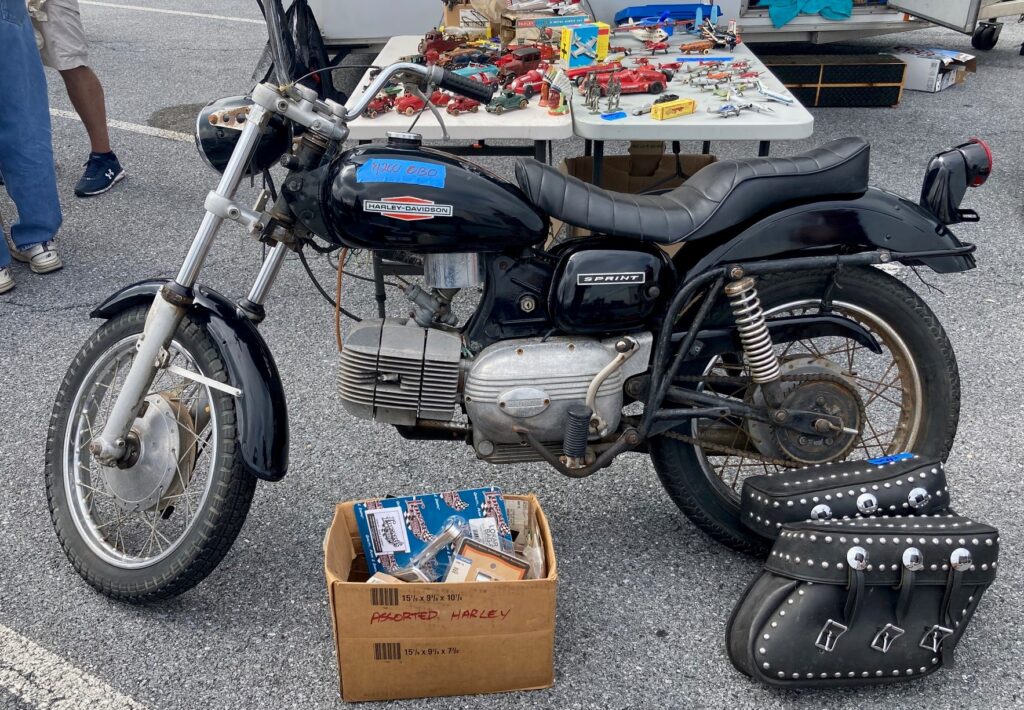
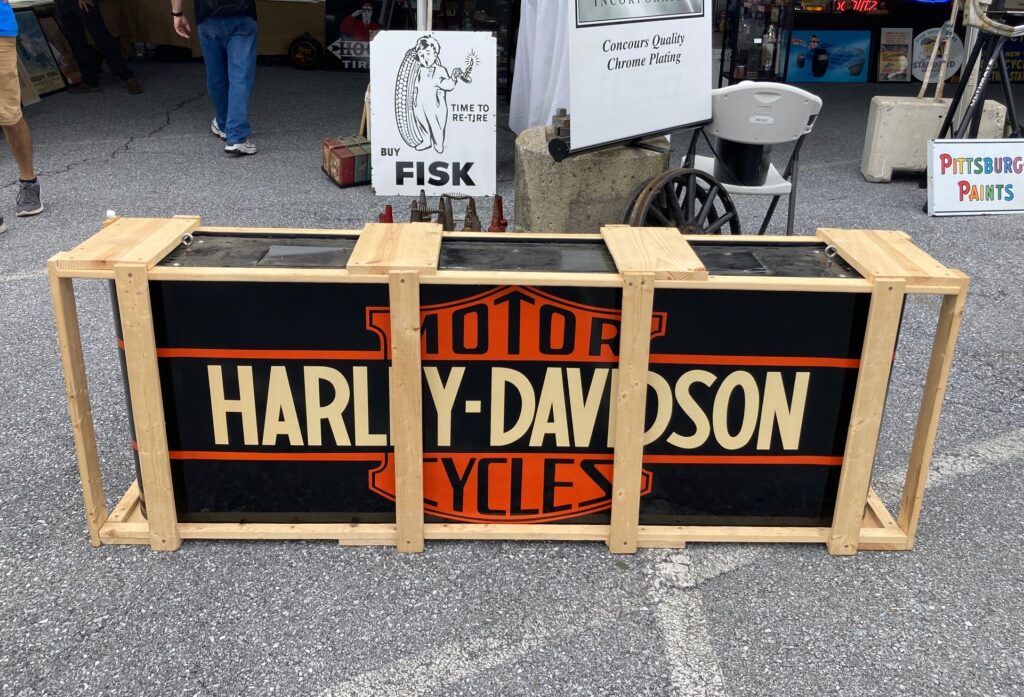
As might be expected, anything bearing the name Harley-Davidson is usually accompanied by an especially high asking price—thought not always. The Aeromacchi-Harley Sprint 350 conglomeration sought to go home with a buyer at a reasonable-sounding $1200. The Harley sign? I didn’t even ask.
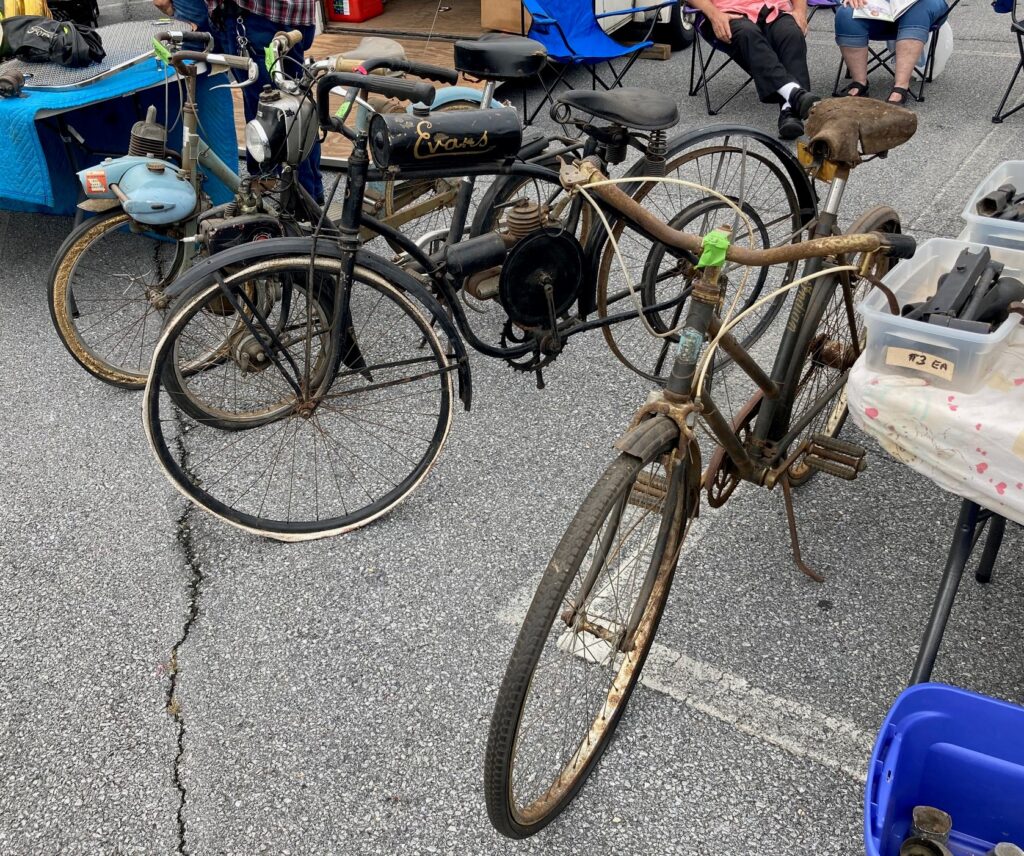
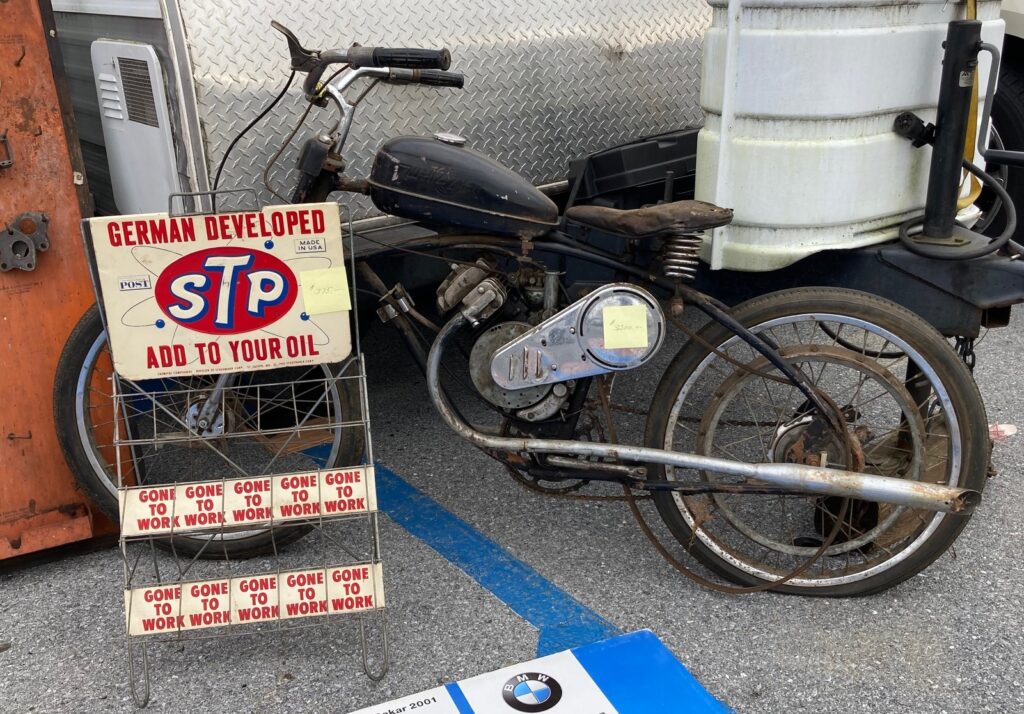
Above top is an early Evans motorized bicycle, along with several early mopeds and a bicycle. If it’s old, and has wheels and an engine, any object can be Hershey material. Pictured below the Evans is the long-time gold standard of motorized bicycles, a Schwinn and Whizzer combo. This example is in rough shape. Plenty of fastidiously-restored Whizzers are available, and—as the motor enthusiast demographic ages out—these machine have come down in price, like Model-Ts. Collectors should be aware that old things don’t always maintain their value through time; in 2000, an excellent Whizzer commanded $3K or more. Now, a fine Whizzer can be purchased for half that, in today’s dollars. The reason is likely that we (the current fifties/sixties age buying demographic) just didn’t dream of Model-Ts or Whizzers like our fathers did, and we aren’t willing to pay the former prices. And be careful: the next generation of buyers may not have desired after the muscle cars that boomers are investing in, so heavily. “For every purpose (and interest), there is a time …”
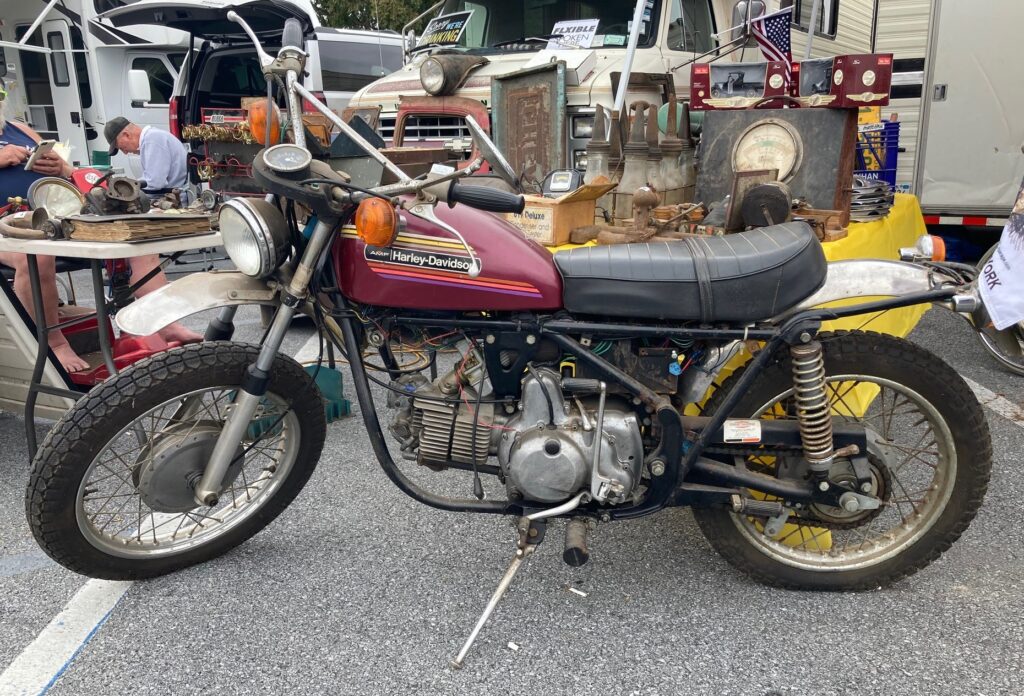
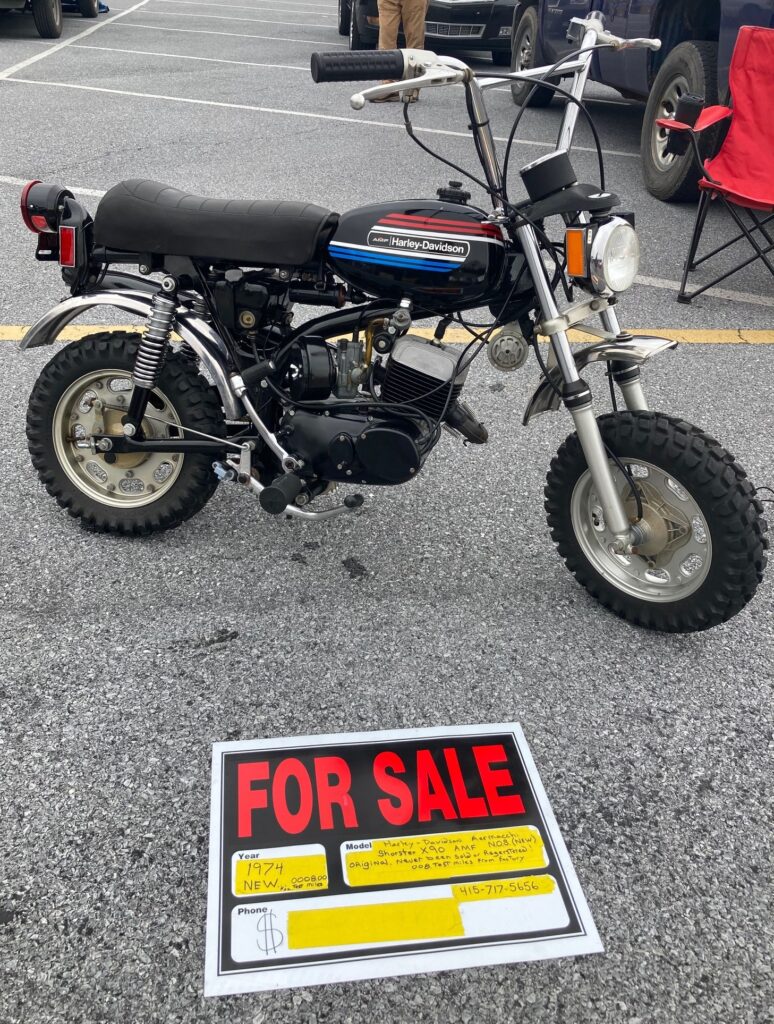
Two more Harleys—another Sprint and an unused, original 90cc minicycle (all Italian-made). The 90 is obviously so valuable that the price cannot be written (perhaps it fluctuates hourly with other high-end stock market commodities), and will apparently be quoted in hushed tones to interested parties. (Forgive me. Harley prices and brand reverence can be funny! Oh, and the 90 eventually sold for $3800.)
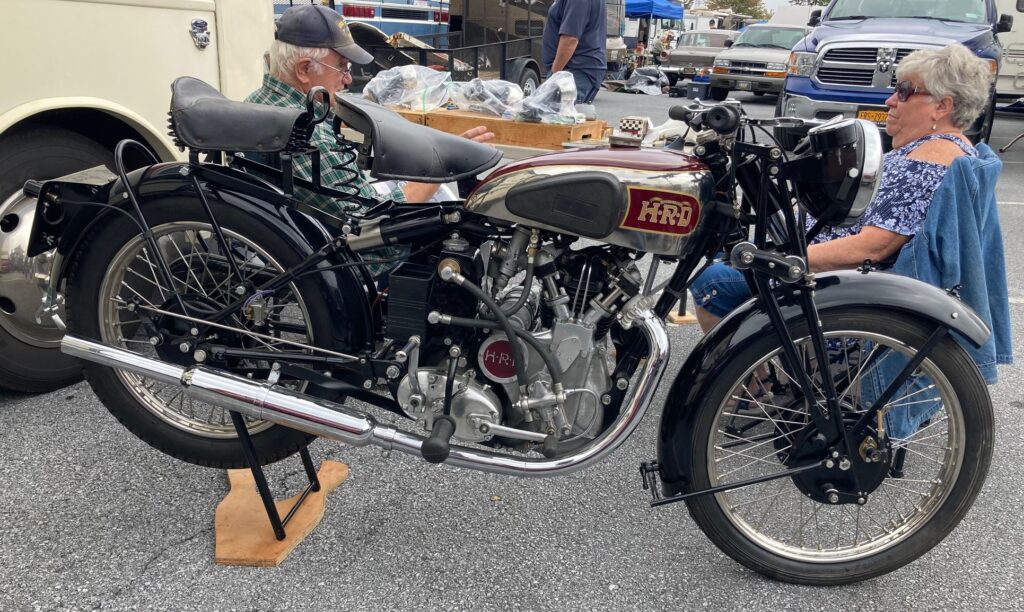
This vertical-single Vincent-HRD is one that I’m sure had many motorcycle enthusiasts doing a double-take. This model, incorporating a vertical “series-A” single is a pre-war example, produced before Philip Vincent’s better-known and more common “series-B” inclined 500cc single and 1000cc V-twin machines. The machine’s older owners want to realize a payment, but they also want see where it goes, next.
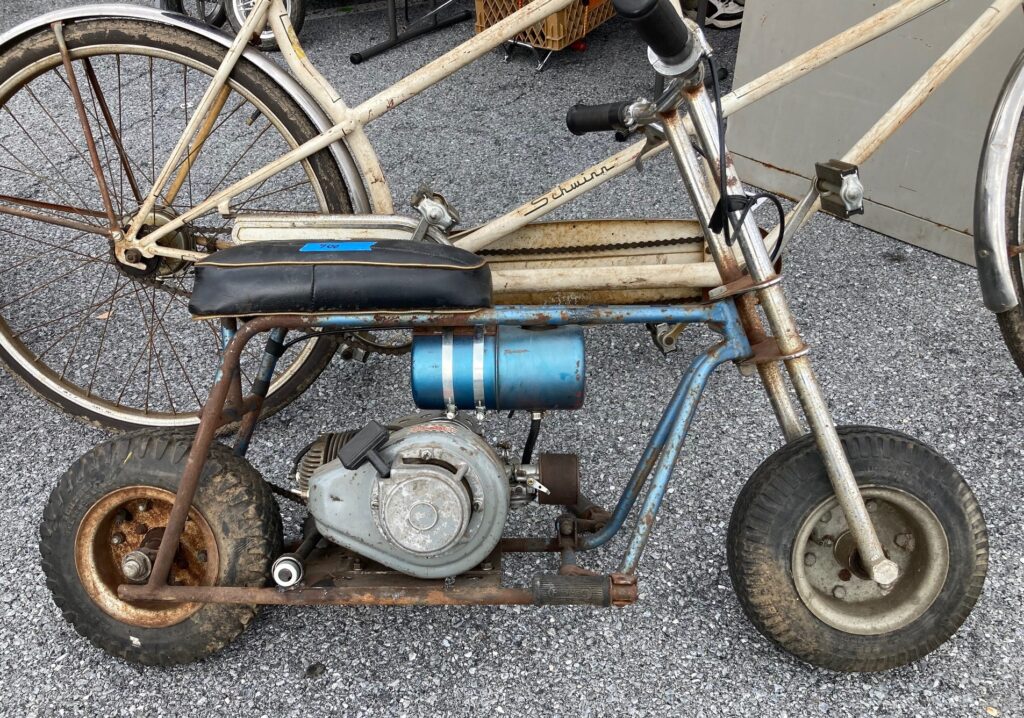
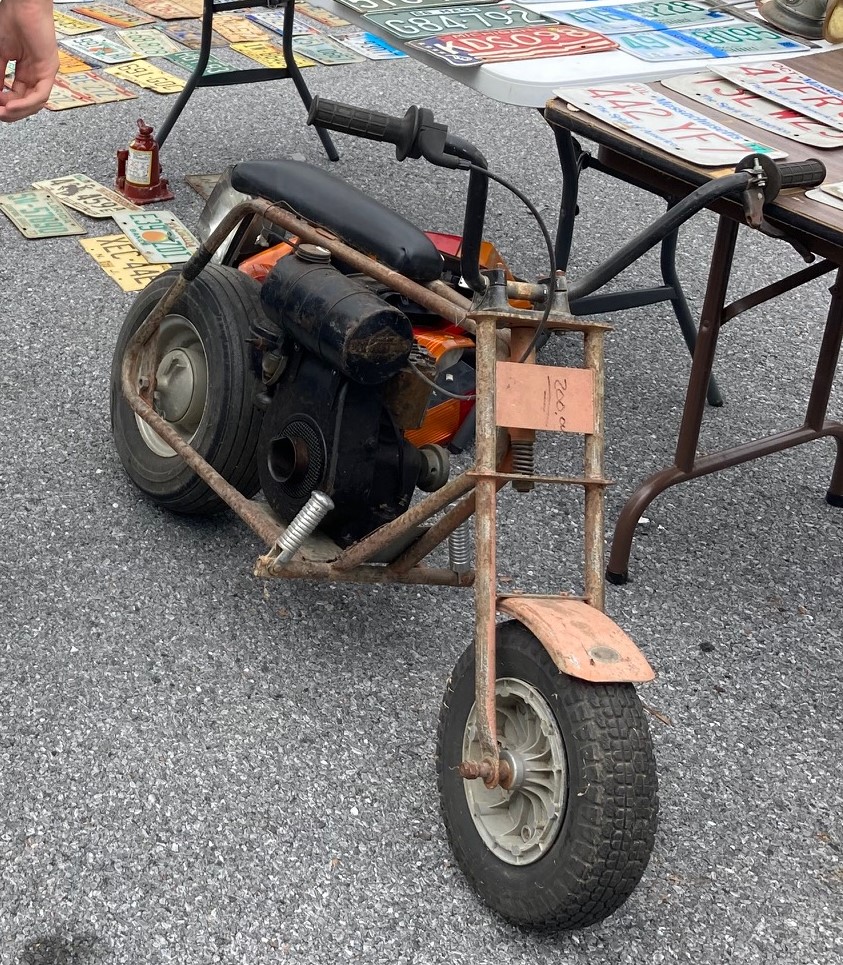
Two minibikes for sale; they appear to be “buyer-supplies-the-engine” kit bikes from the 1960s, just prior to the “motorcycle boom” of the early 1970s. $400 (top) and $200, respectively, and certainly some fun for a new owner. (The alloy wheels on the bike on the bottom are intriguing!)
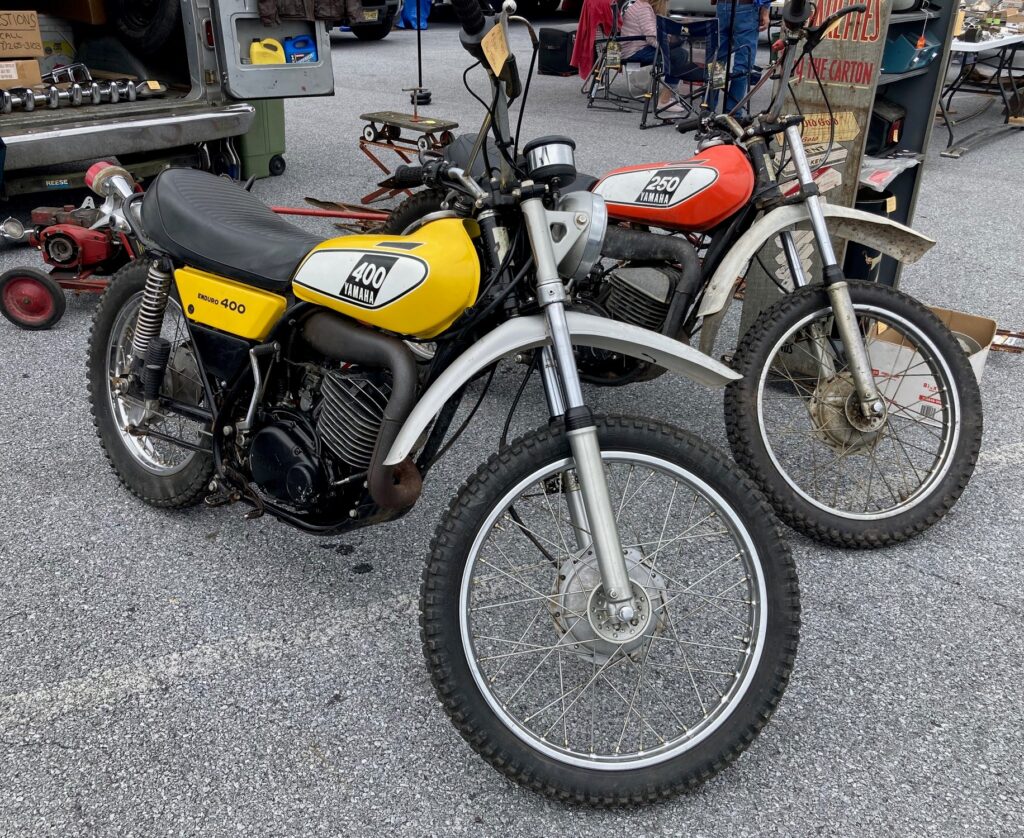
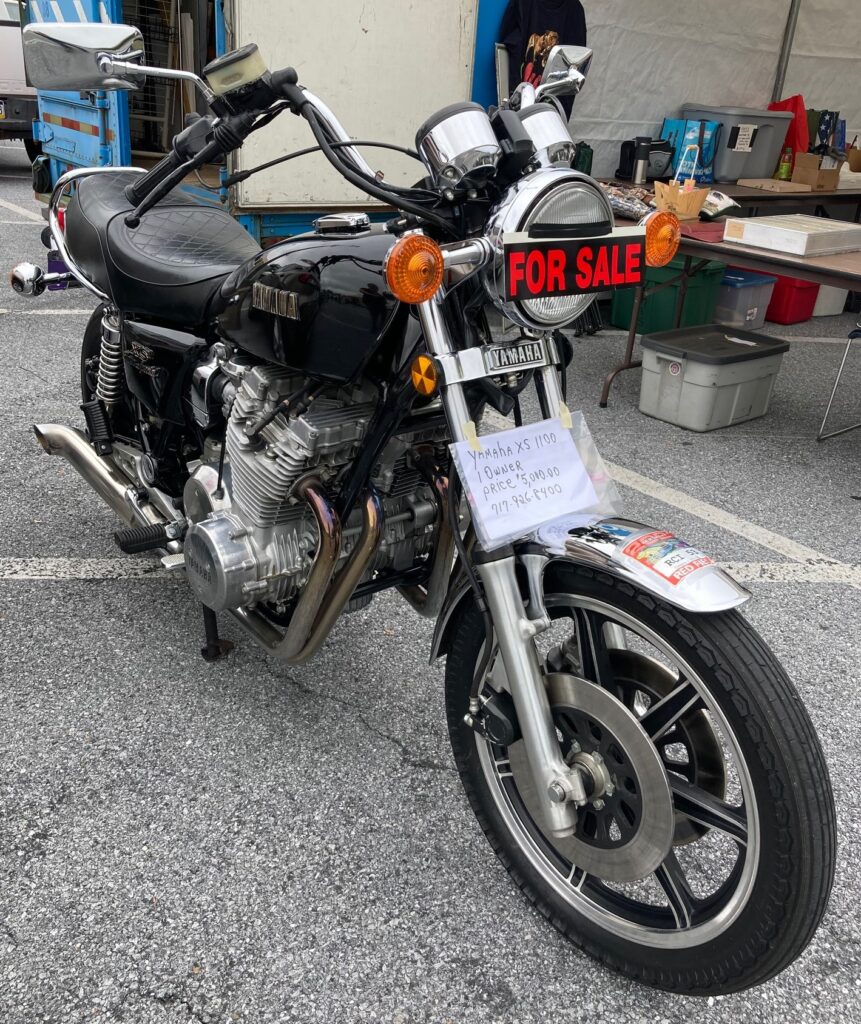
A rather nice pair of 1975 Yamaha DTs—a 400 and 250. During the motorcycle boom years of the 1970s, some families would buy two bikes from their dealer—one for dad, and one for mom or the kids. (My family was not a “What-the-heck?-Let’s-get-more-than-one-bike-while-we’re-at -it!” type of family, just for the record; obtaining a single real motorcycle in an entire youth-hood remains just this side of amazing—and still appreciated.) Below the DTs is what was somewhat derisively once known at the “UJM” (Universal Japanese Motorcycle)—a four-cylinder 1970s/1980s Japanese bike that was inexpensive, utterly reliable, very nicely detailed … and yet still would still come up missing a certain something that its detractors seemed to think was essential for a ‘real’ motorcycle.
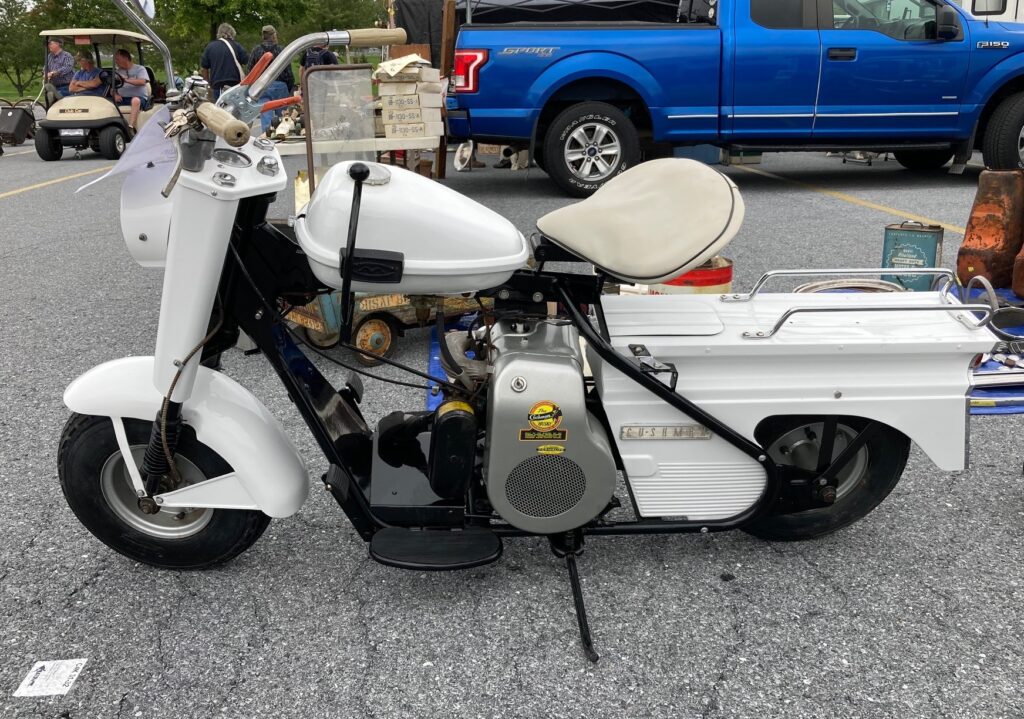
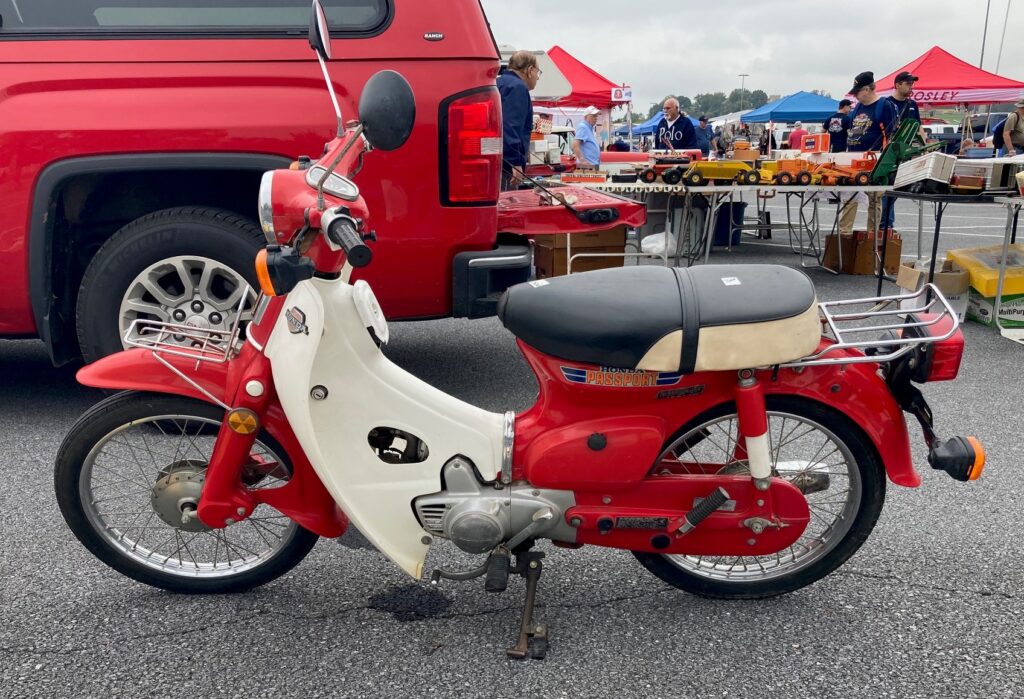
Transportation made simple and affordable. Above (top) in white is a restored circa 1950 Cushman. Like Whizzer, the Cushman was long a favorite for boomers who hadn’t been able to have one as a kid in the 1950s. And, as is the case with Whizzer, Cushmans are no longer appreciating. Below the Cushman is a motorcycle that I understand may be the most-produced in the world: the Honda Passport. This older example is ready to provide fun and reliable transport to its next owner. And, no, parts will not be a problem!
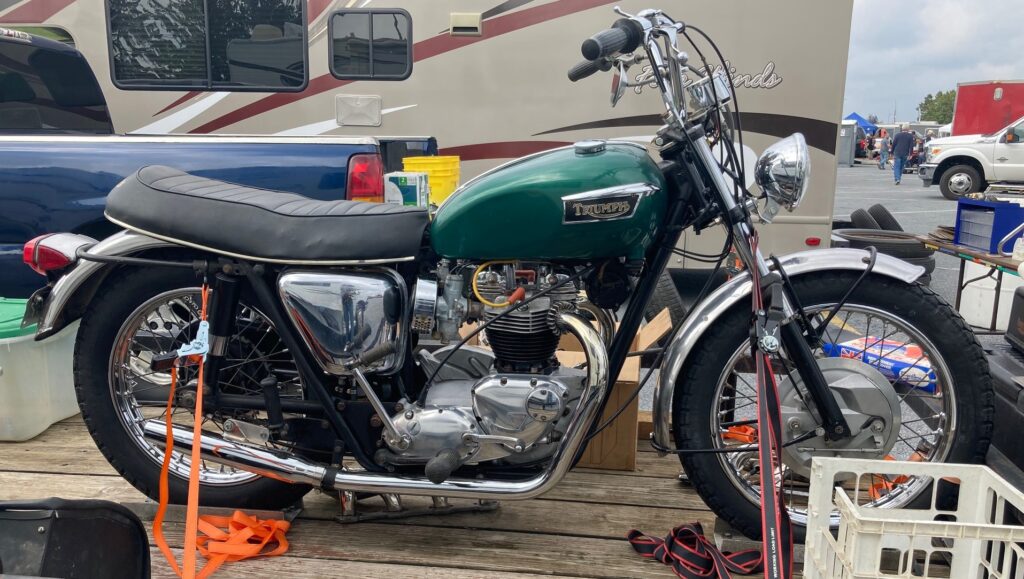
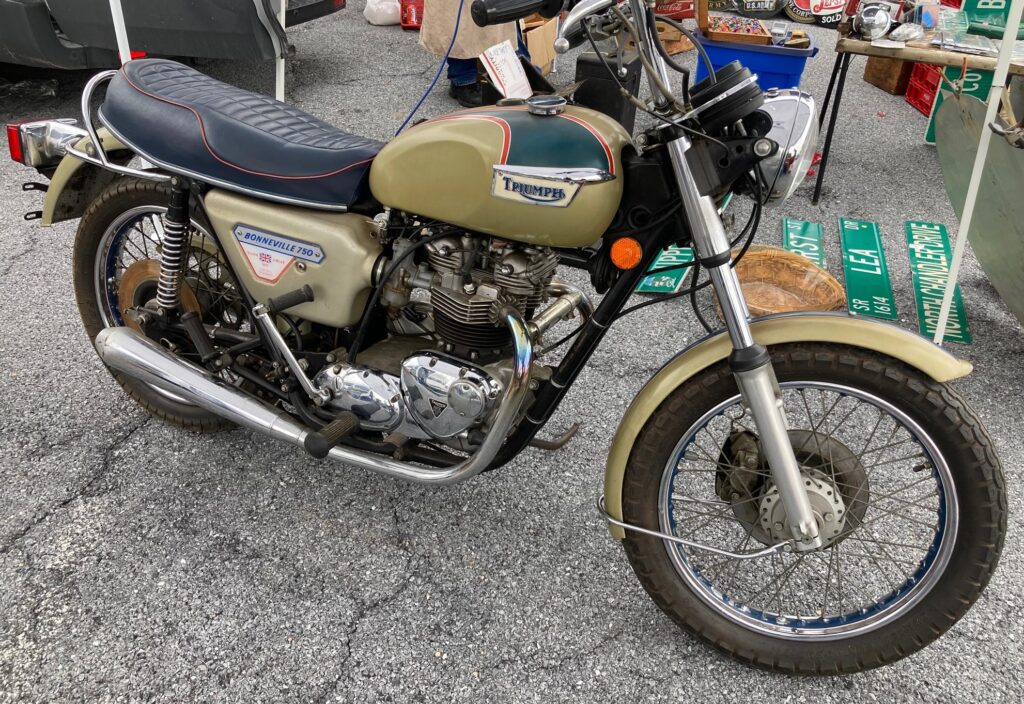
Two interesting Triumphs. The slightly modified circa 1970 650cc model up top is one of the last with the separate oil tank, and is slightly more prized than later “oil-in-frame” models by Triumph aficionados. The machine below it is an American/export-model “Silver Jubilee” 1977 750cc model, created as “one of a thousand” to commemorate Queen Elizabeth’s 25th year as regent. (Given the many Silver Jubilees around—I have seen two or three turn up the same day at small local British motorcycle shows—the “one of a thousand” quote may be questionable.) Though beautifully painted (including red, white & blue striping on the rims), this example’s silver paint has yellowed, and would likely be a candidate for a full cosmetic restoration.
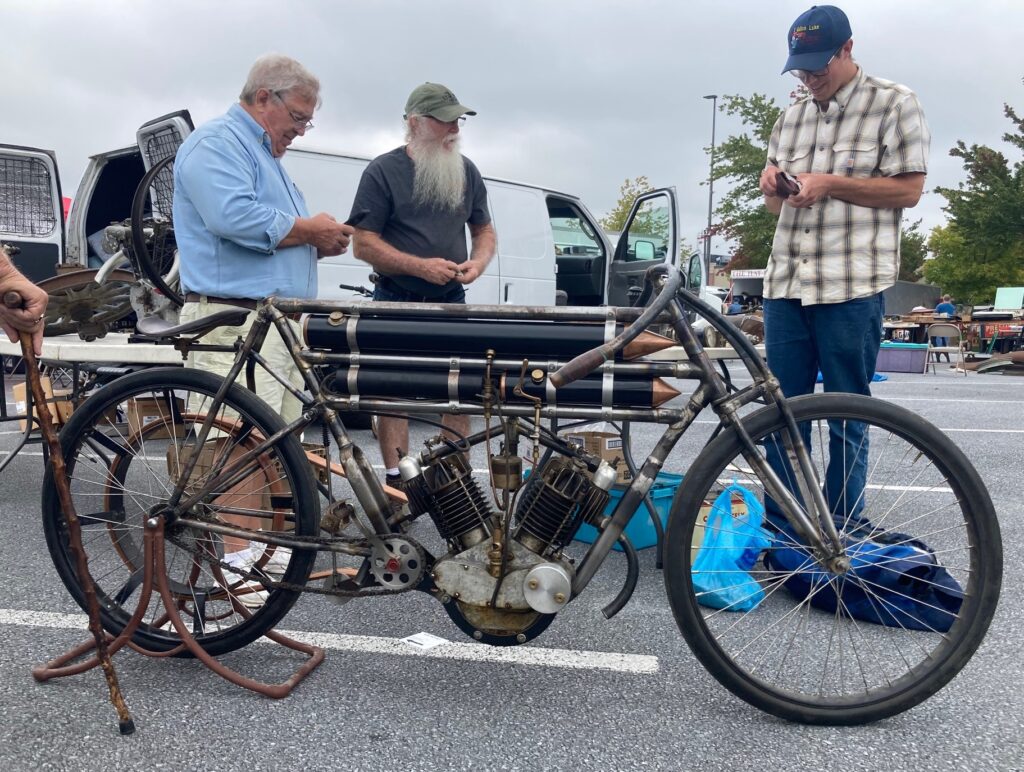
This is a new idea: ‘garage art’ made from antique motorcycle (and other not necessarily antique or motorcycle) parts. The concept seems to be to replicate very early motorcycles from a few authentic—though not necessarily matching—parts and whatever else the maker can find in his garage, and produce affordable but yet interesting conversation pieces. I noted two vendors selling these—and all offerings sold.

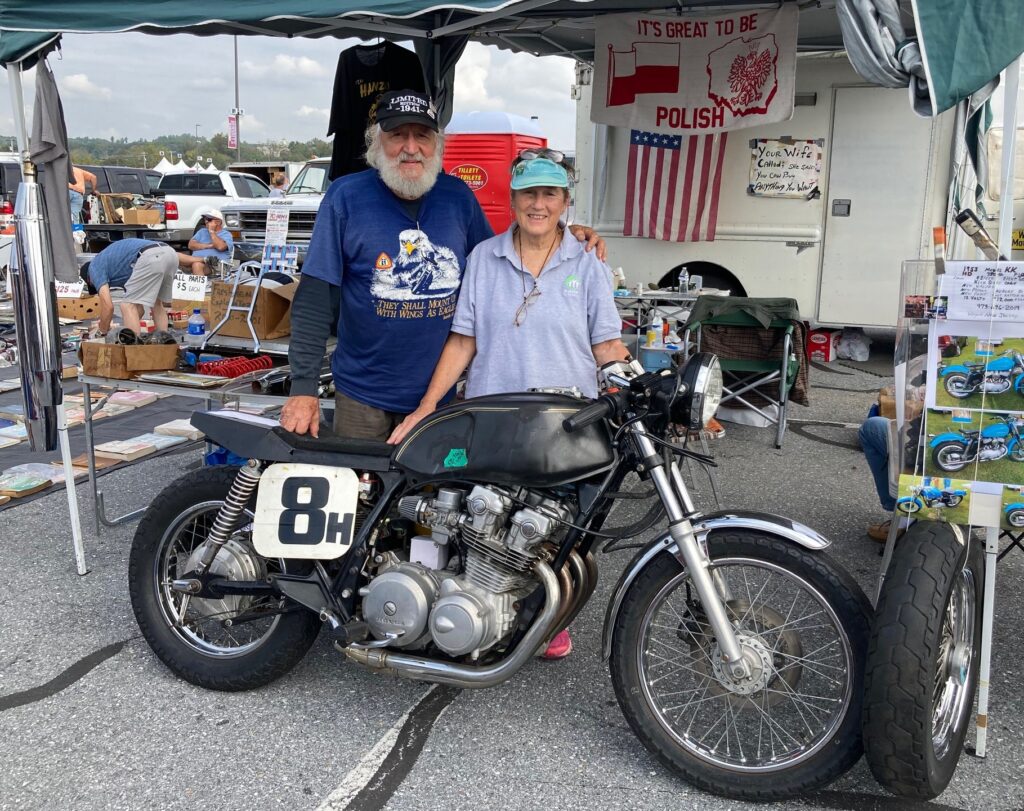
“You meet the nicest people!” AACA Museum employee and local scooter magnate Rob Kain rolls a new find to his spot. Rob noted that this example was too far gone to restore, but that several parts on it were worth substantial value to restorers. Below Rob, Hershey regulars Henry and Mary Alice Hanzo from New Jersey. Henry brings things like old vices, jacks, motorcycles and other heavy things to sell, and Mary Alice feeds Henry.
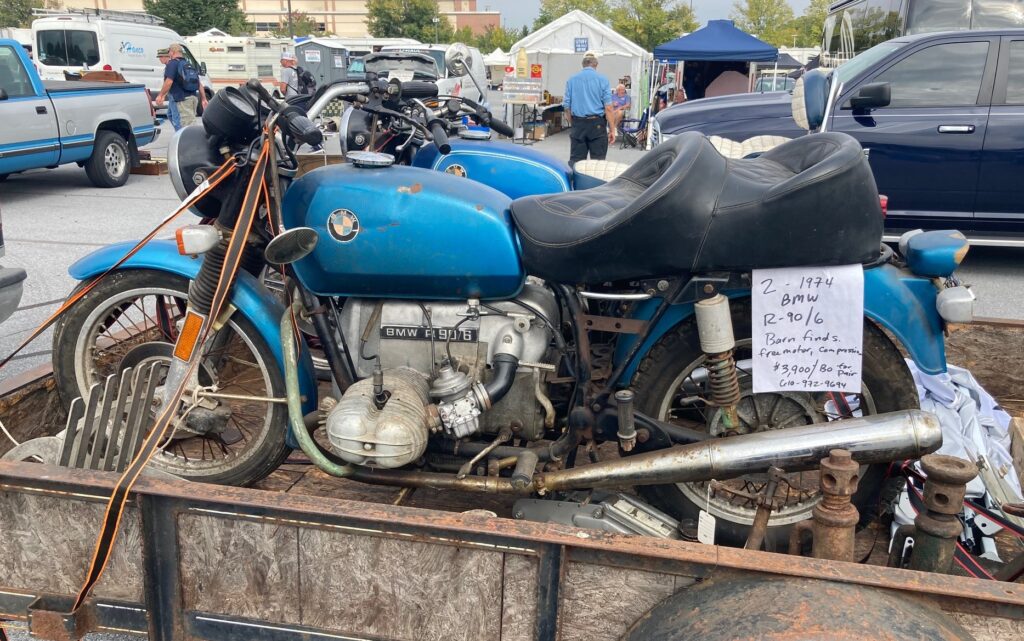
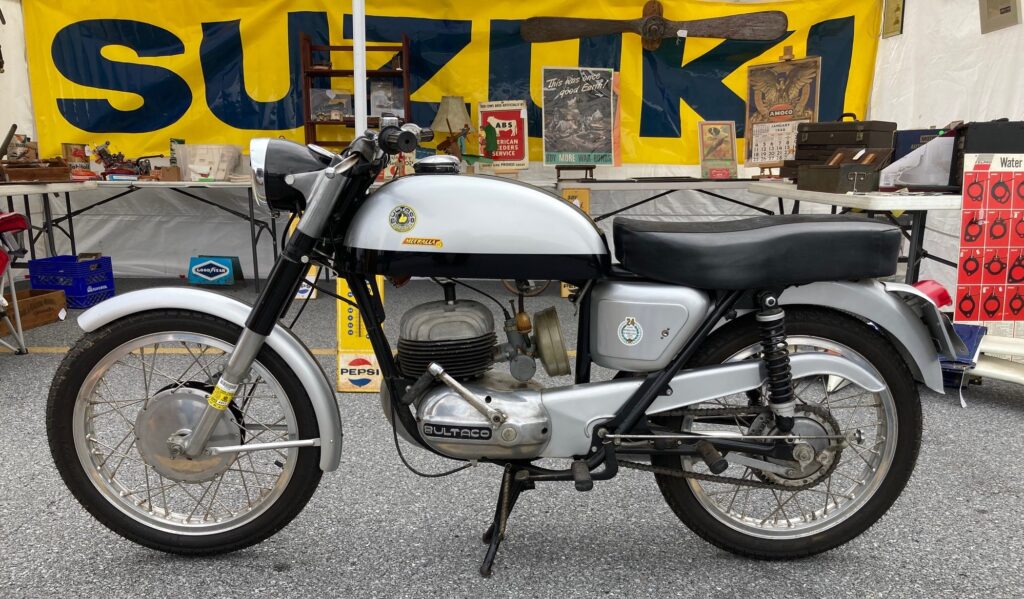
On top, a matched pair of 1974 BMW R90s. Maybe a good deal at $3900 OBO. A good friend has a rule of thumb when buying used motorcycles: Always assume the engine is bad … unless it’s a BMW! Below the Beemers, a very nice circa 1968 Bultaco Metralla 250. Road-going Spanish motorcycles were and are not common in North America, but are undoubtedly elegant and prized by collectors.
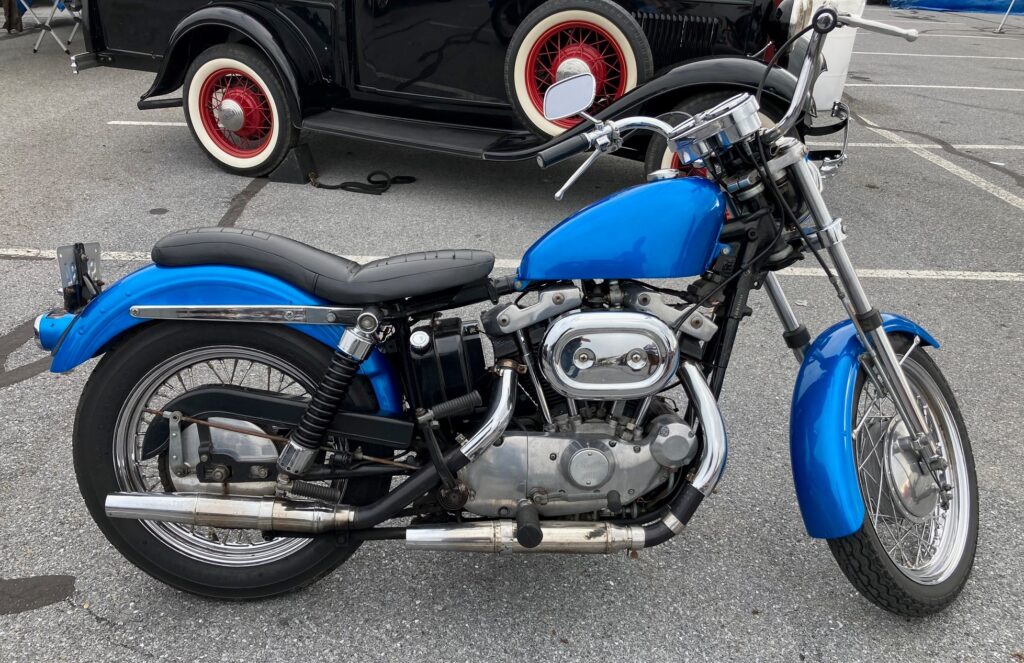
Yes, just a mid-seventies Harley Sportster—and I want one. (At least while they’re still relatively cheap.) Not to ride, just to restore and park in the garage and stare at. If so inclined, you should grab one, soon. Up from about $2500 just a few years ago, a ‘pretty good’ Sportster from the seventies will probably now set you back twice as much.
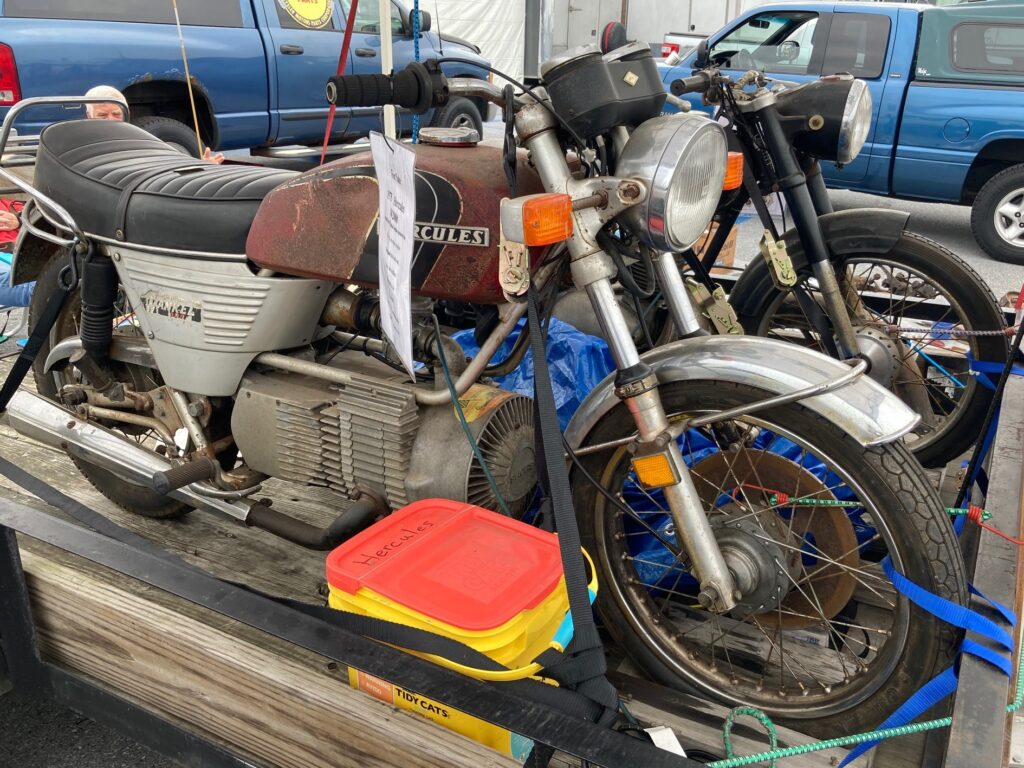
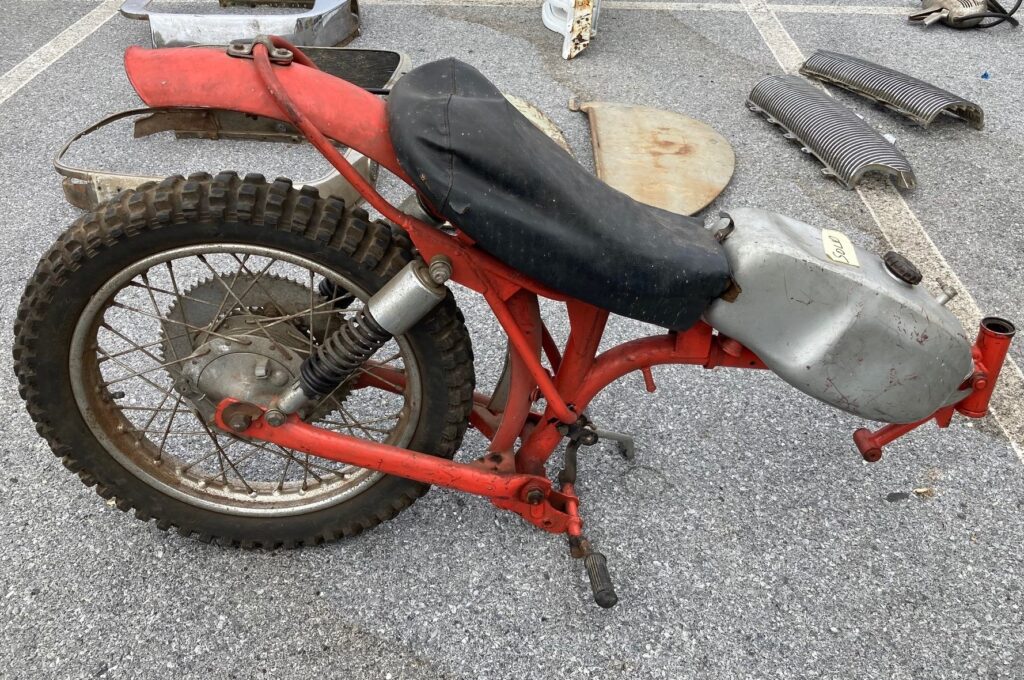
I’ll end the motorbike sections with this shot (top) of a 1970s Hercules wankel-engine bike, and a circa 1950s DKW. They are in the same trailer they were in, years ago, when I first noticed them. Does the owner really want to sell? Or are they very heavy conversation starters? Below the Hercules is the crusty remnant of an Italian-made Harley Baja 100, circa 1972; talking to the buyer, you’d think he had discovered gold.
Bicycles and other things that one would pedal
Just below the old car theme is Hershey’s underlying purpose of bringing together all the things that Americans of a certain age had, or wanted, when they were kids. Naturally, pedal toys and bicycles figure into this category. Pedal cars have long been hot garage-art items; I don’t know how pedal tractors figure in, but they are always present.
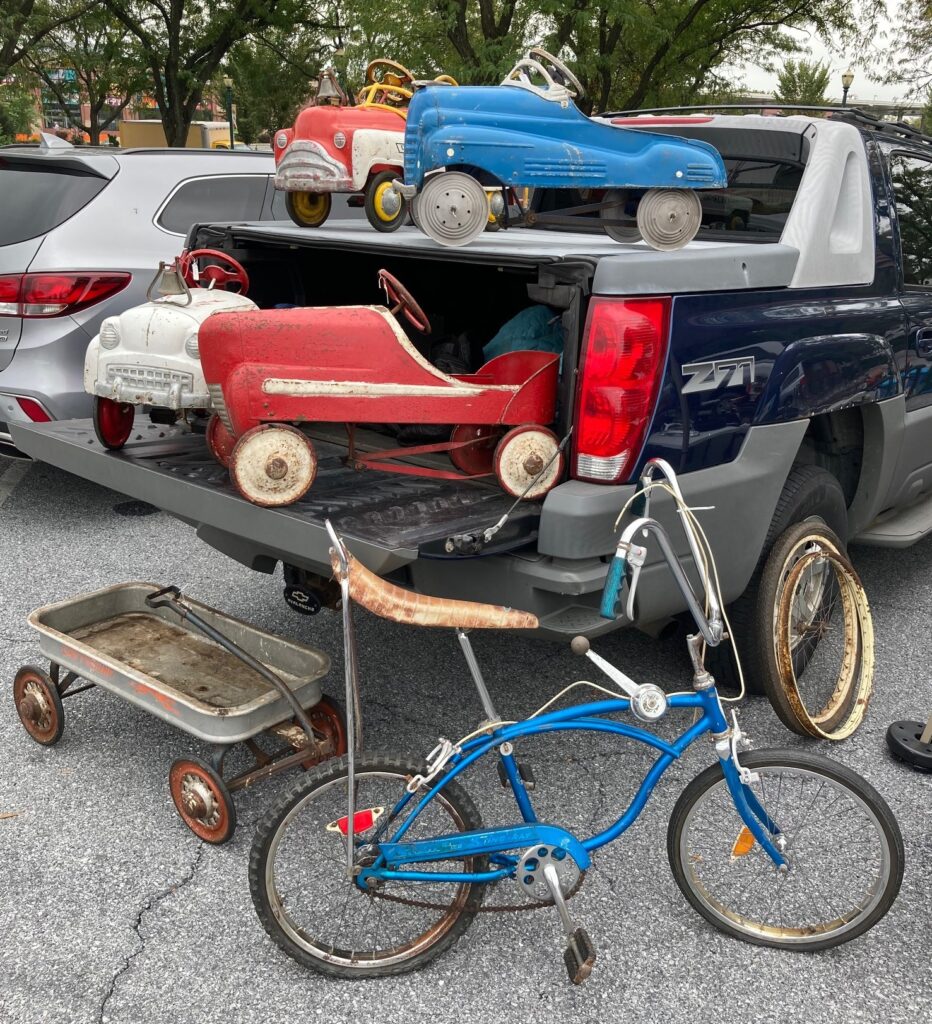
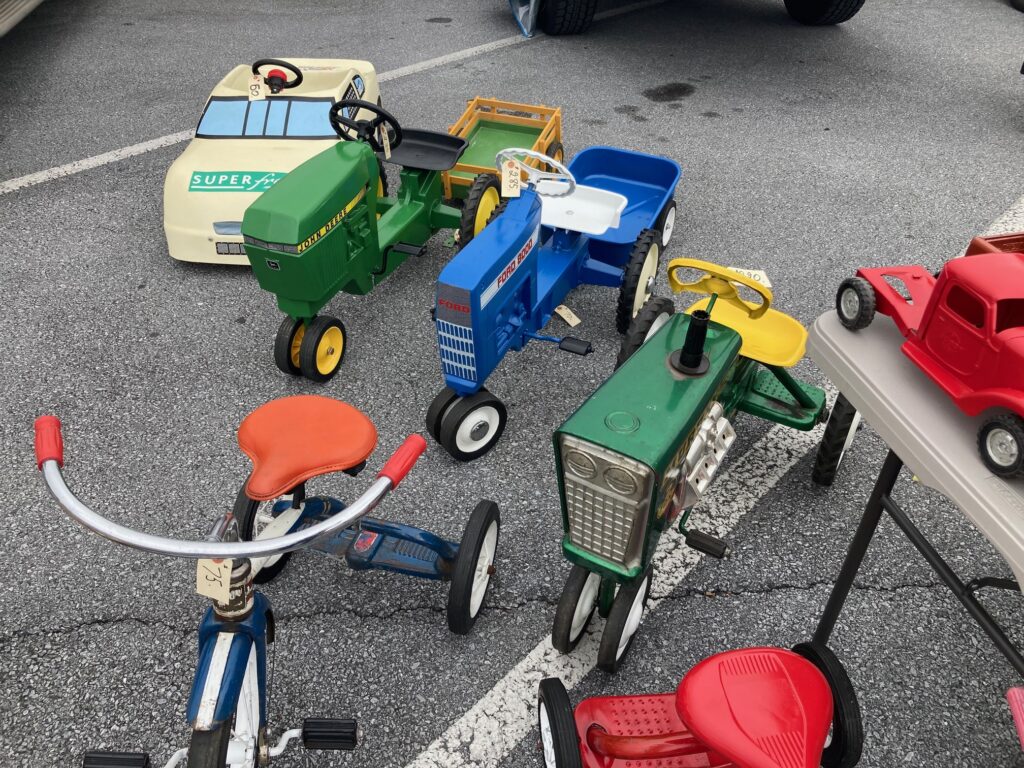
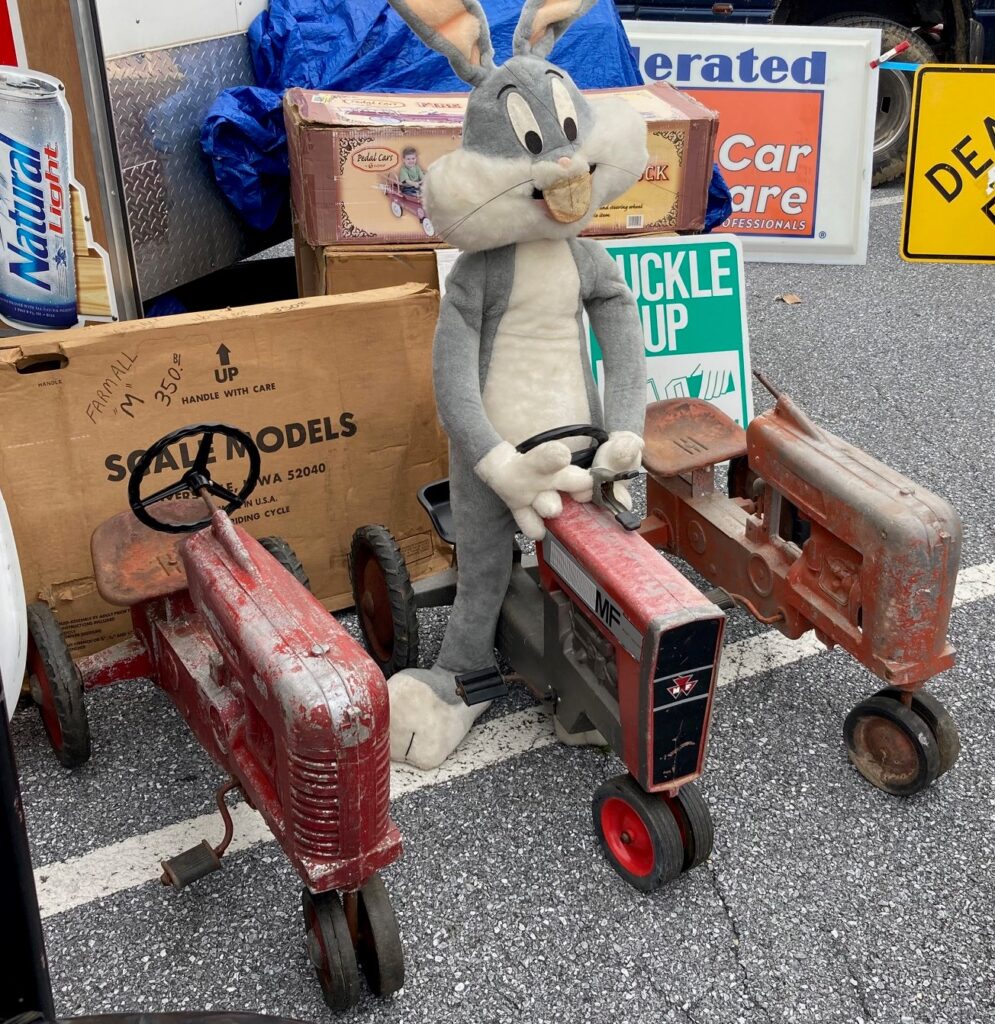
Pedal cars can fetch thousands of dollars. Wagons, tricycles, bicycles and pedal tractors are generally less pricey. Note that the two tractors on the right are apparently cast of solid aluminum (like period playground equipment).
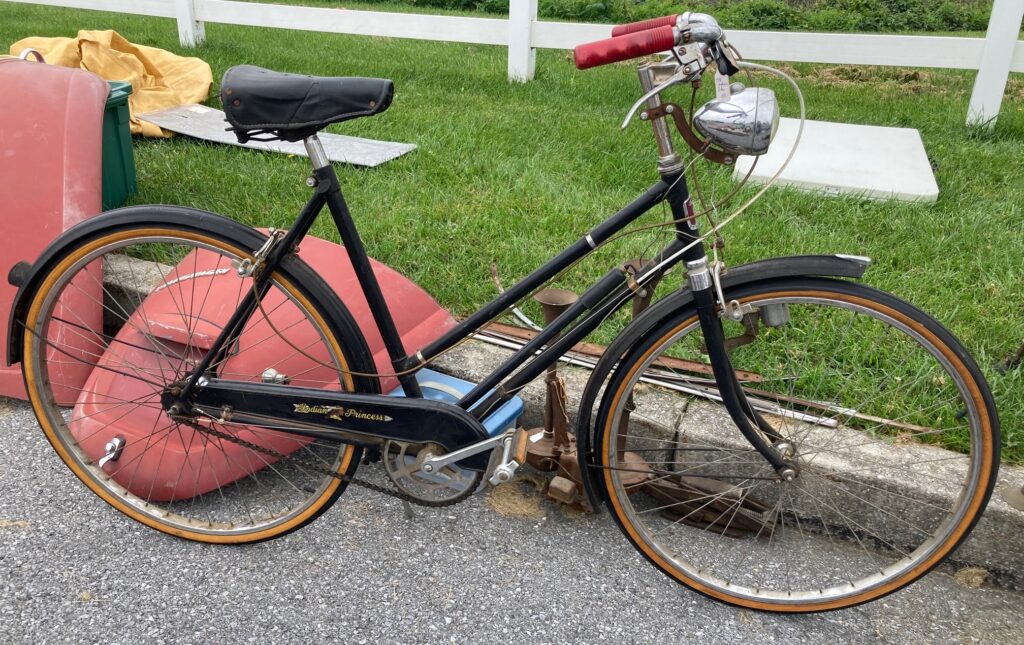
Although there was near-zero rational reason for doing so, I purchased this 1952 Indian Princess 3-speed bicycle to hang in the basement motor cave. The Indian Company, in its last years before bankruptcy in 1953, commissioned England’s Raleigh Bicycle company to produce the bike for sale in Indian dealerships. This example was ridable, came with several extras (hand pump and lighting) and had been kept indoors and ridden by the previous owner.
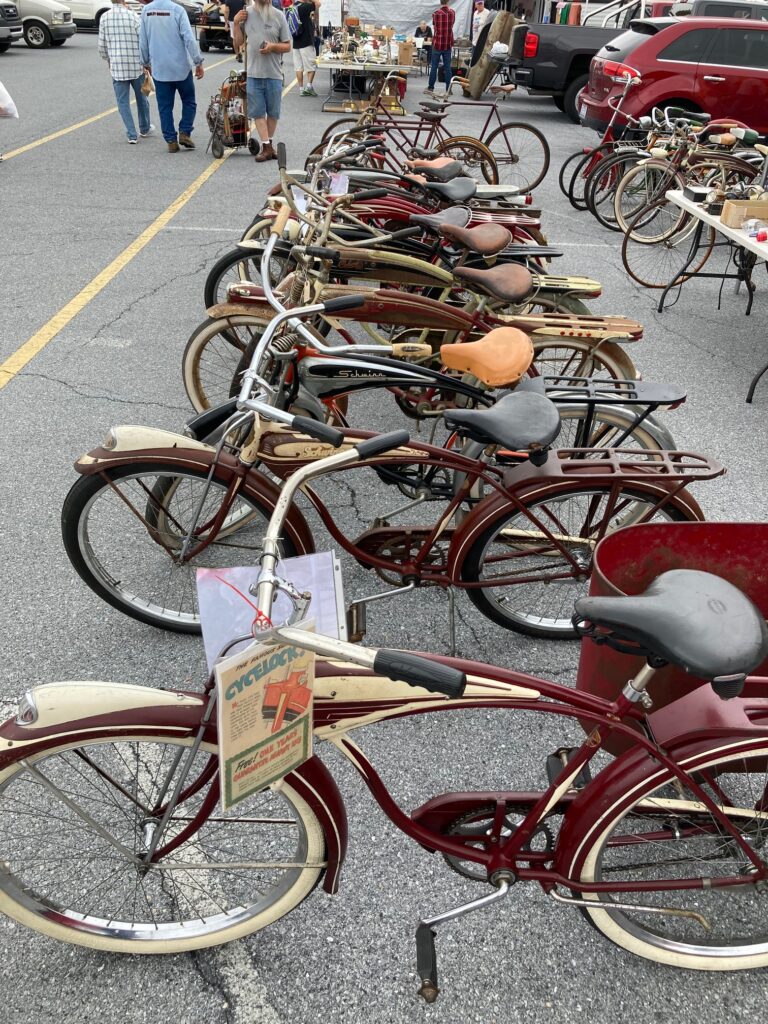
Bicycles were once primary transportation for young Americans. These circa 1940s restored examples show the beauty that went into the design of the characteristic “balloon tire” American bicycle. Why did these have big tires and brightly-painted frames, while European bikes generally had thin tires and elegant, petite frames? (I can answer the question with respect to American vs. European motorcycles, but the bicycle answer eludes me.)
Other Americana
Fall Hershey is also a giant male-oriented flea market, centered on anything even remotely related to American automotive culture. And ‘remote’ means linked by the most tenuous relationship; as in, if it was made in American from the time of the first car, it qualifies!
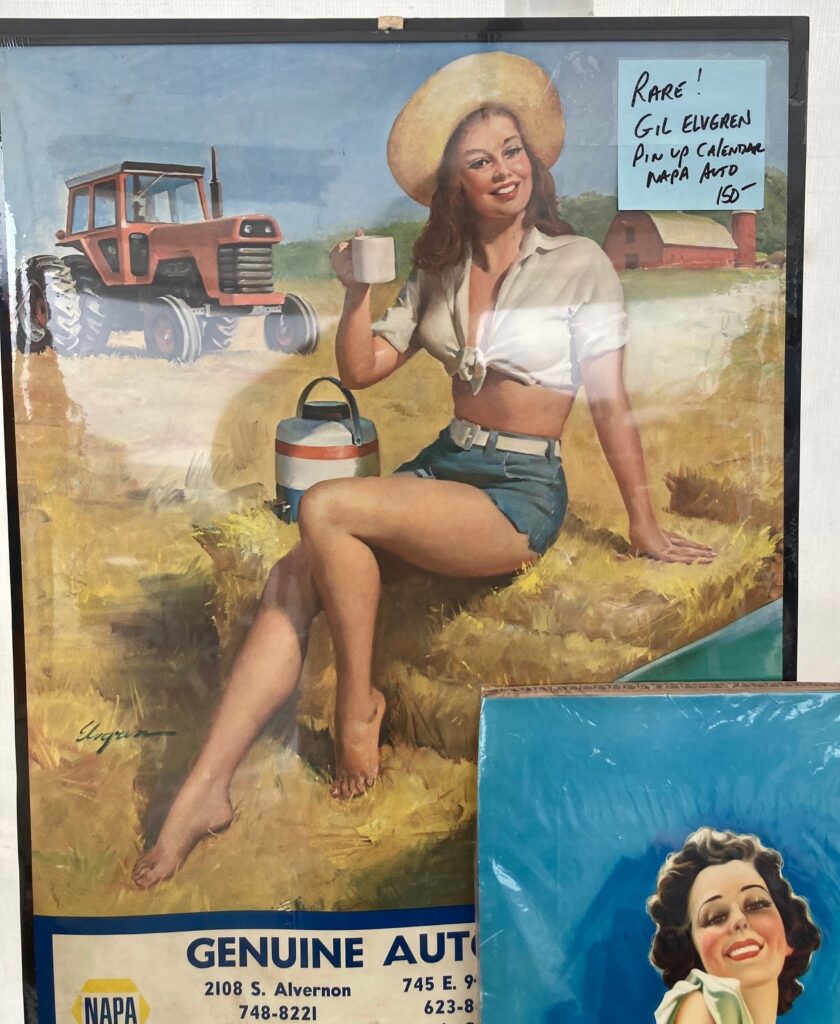
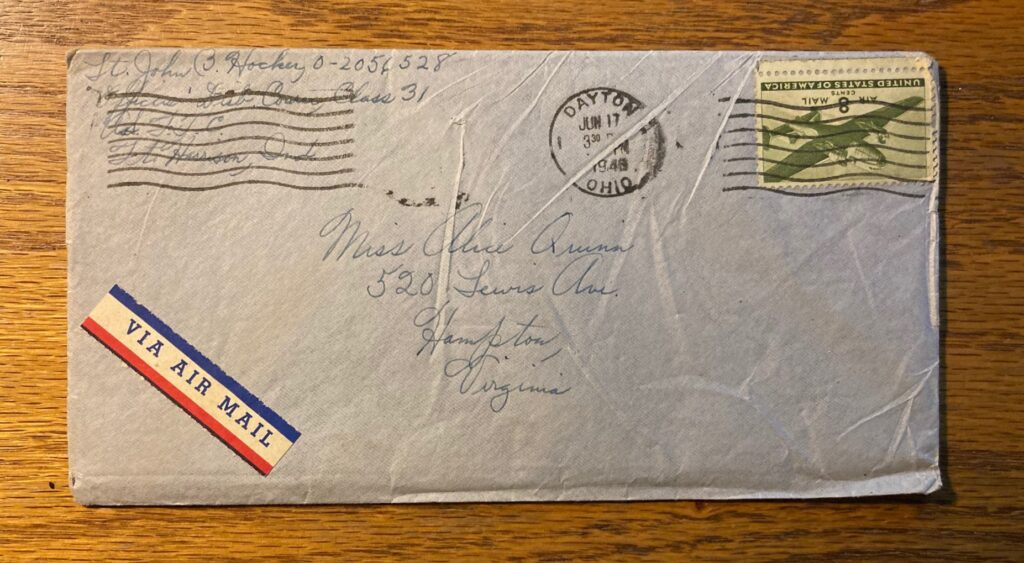
These two items were being sold by the same vendor. On the top is an original calendar from that time in American when illustration, not photography, was the preferred advertising visual medium. Gil Elvgren was one of the pre-eminent rock-star illustrators of this time. Below the calender is a letter written in 1945 to a Miss Alice Qruna, from a Lt. John Hockery. The letter—like the hundred others in the same box—was never opened by Miss Qruna. What Lt. Hockery didn’t know was that his girlfriend had by then married another man. (The letter will be opened by WWII enthusiasts, later this month.)
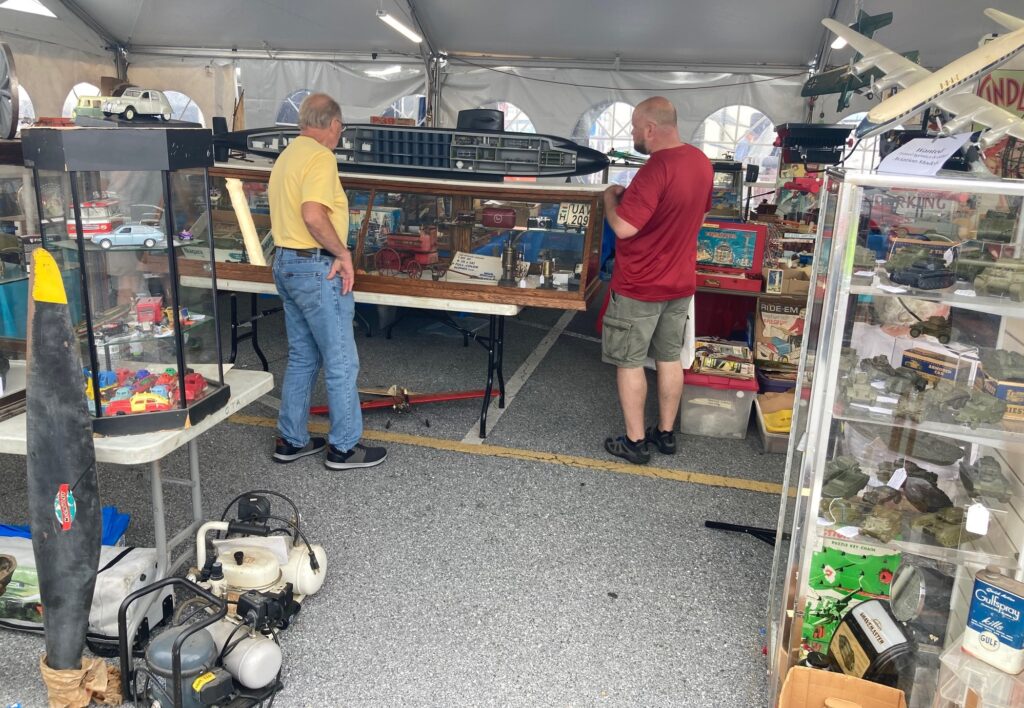
Toys—in this context meaning literal toys for kids, not the bigger ones with engines for old guys—are common at Hershey. Some vendors, like the one pictured, deal in high-end items and rarities, with commensurate big prices. Besides the model submarine (likely a military training aid, to be precise), this vendor has flying and presentation model airplanes, World War II armored vehicle identification aids, antique lamps and tools, and toys.
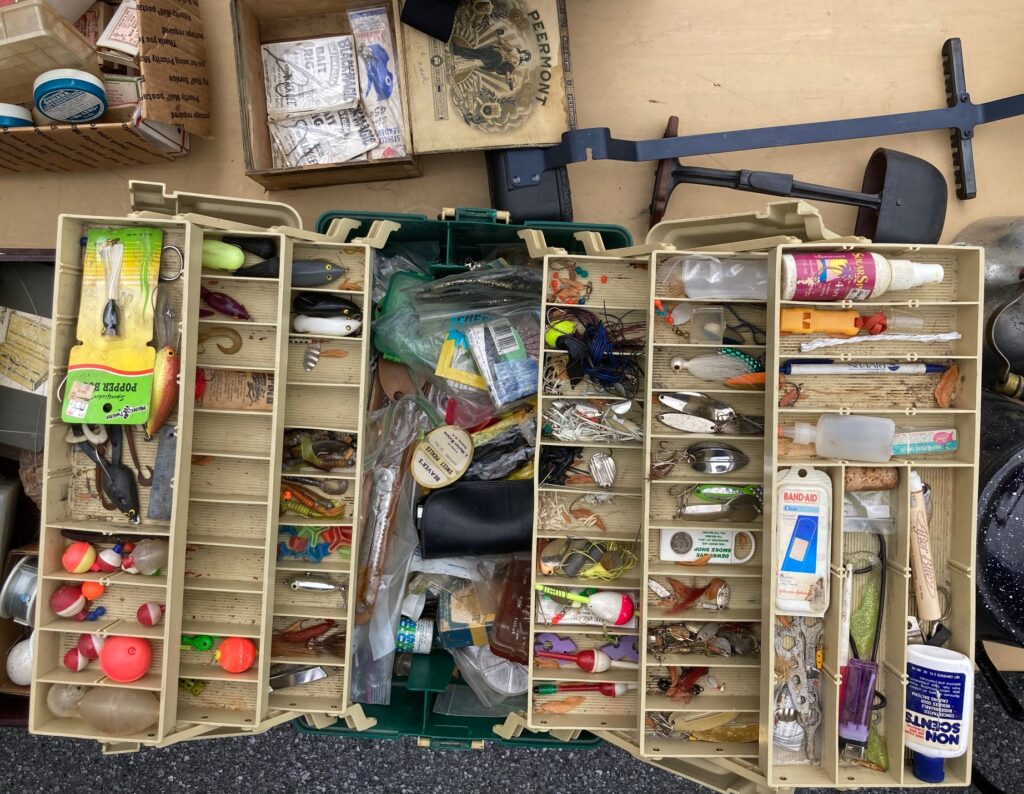
Somebody’s old fishing tackle box, possibly undisturbed from the last time he or she closed it, at the end of a beautiful summer evening, decades ago, on a quiet lake in … somewhere. Walking the aisle of Hershey is to engage in the reconstruction of a thousand American stories.
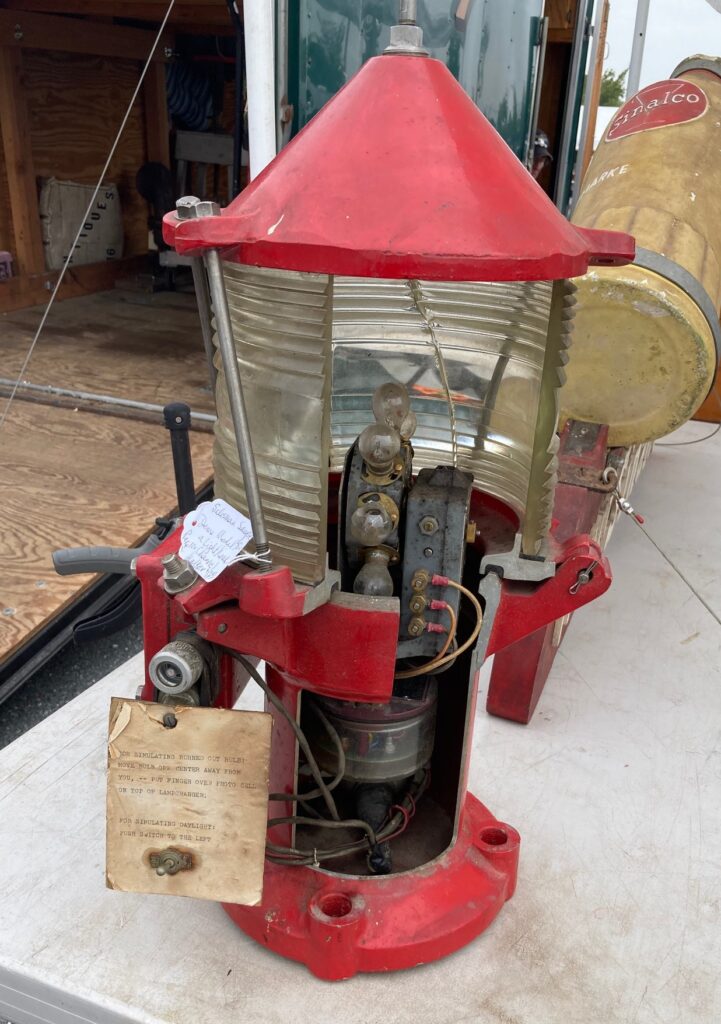
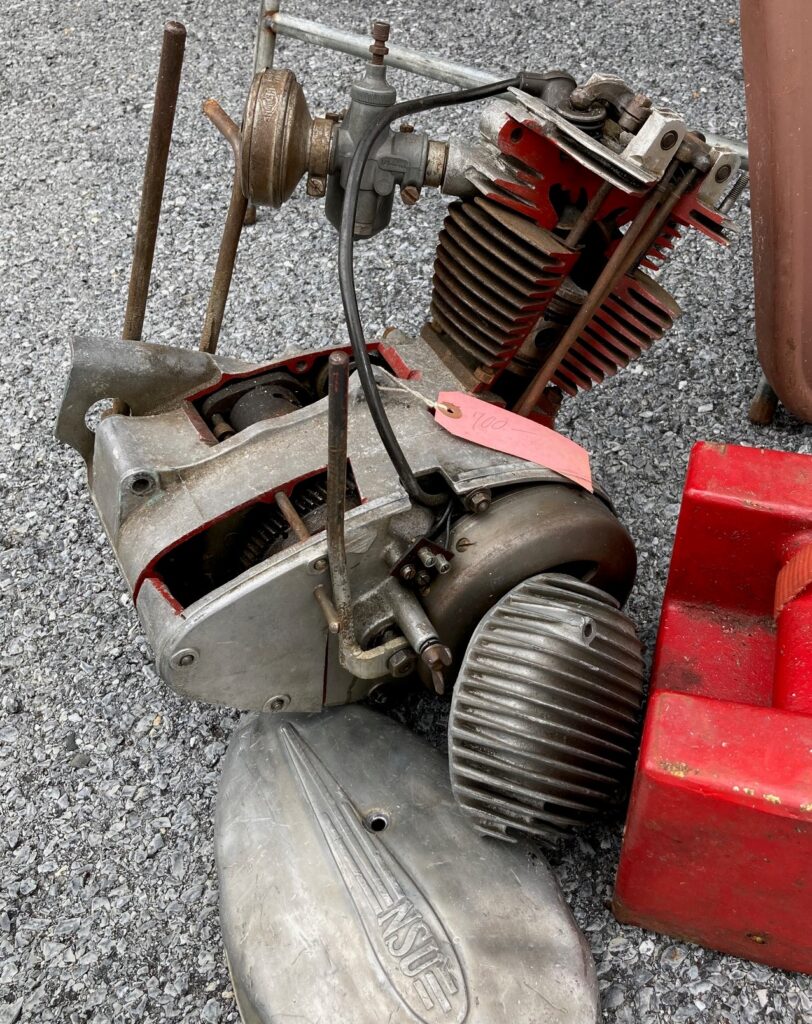
Two fascinating variations on a theme—and two disparate items you’d probably only find at Hershey! Both these items are mechanical “cutaways”—actual production items that have been cut away to show how the object works, is designed, and can be serviced. First is what appears to be an electrical marine beacon (light), possibly that used to illuminate buoys. Below that is an instructional NSU motorcycle engine, cut to show operations and how it goes together. These objects, though of probably no practical use today, are fascinating for both their inherent craftsmanship and rarity.
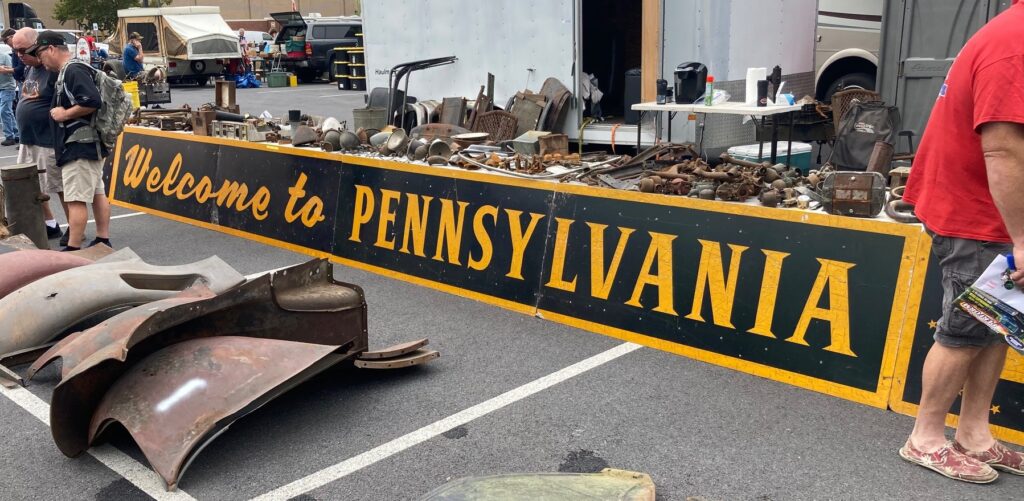
Another story to reconstruct: This sign appears to be an official Pennsylvania state welcome sign, posted on a major highway; likely the PA Turnpike. Was it replaced, many years ago, set aside—and a worker later pulled it from behind the turnpike building? How many people passed under this sign, on their honeymoons, in despair, running from the law, driving to a new life, coming home from war? All before man landed on the moon. Now—what could you do with such a sign?
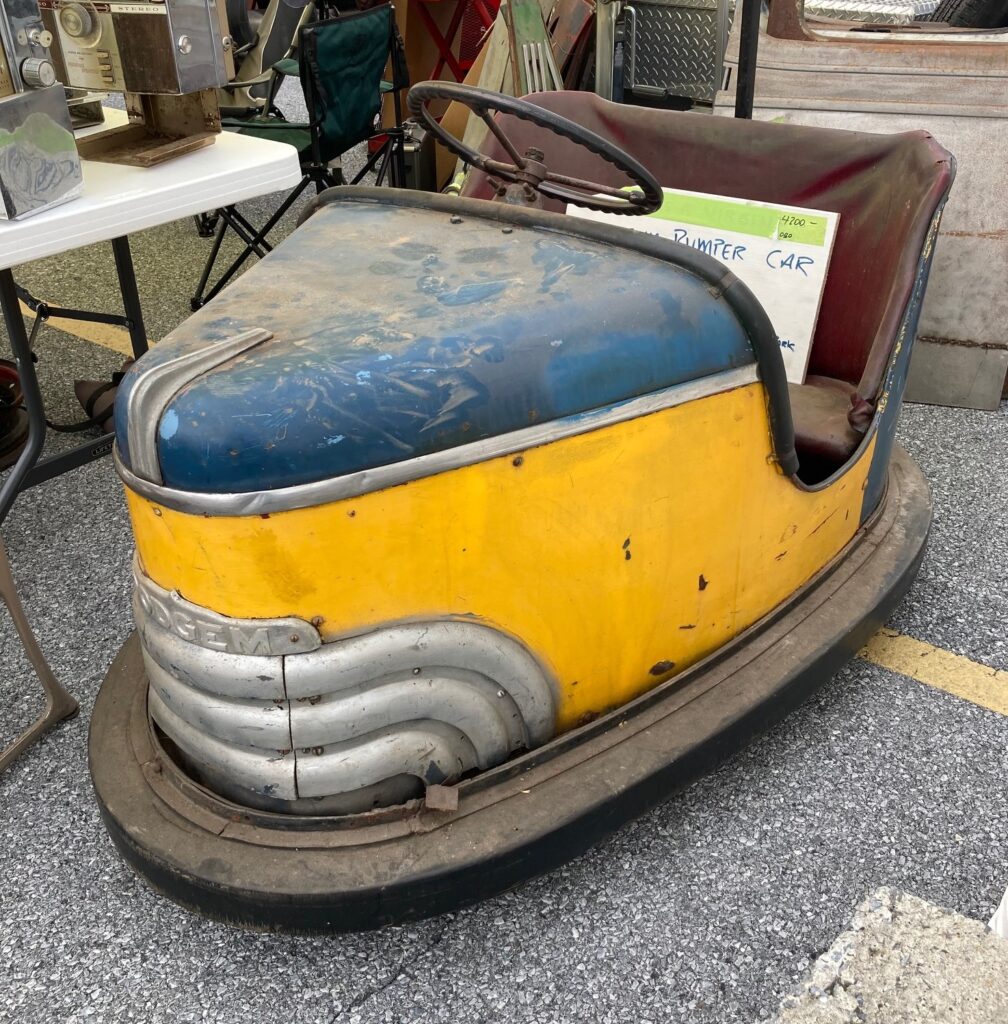
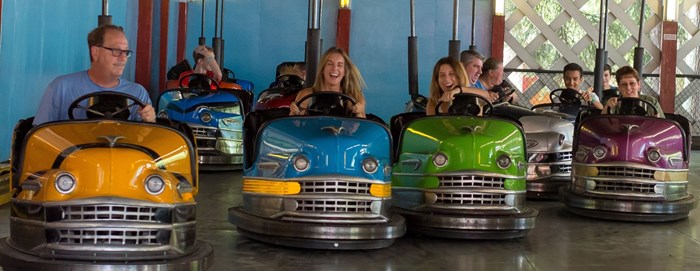
An antique bumper car. These are still a popular attraction at vacation destinations, as shown in the contemporary Knoebels Grove (park in central PA) ad, below the antique version. The antique car was priced at $4000.
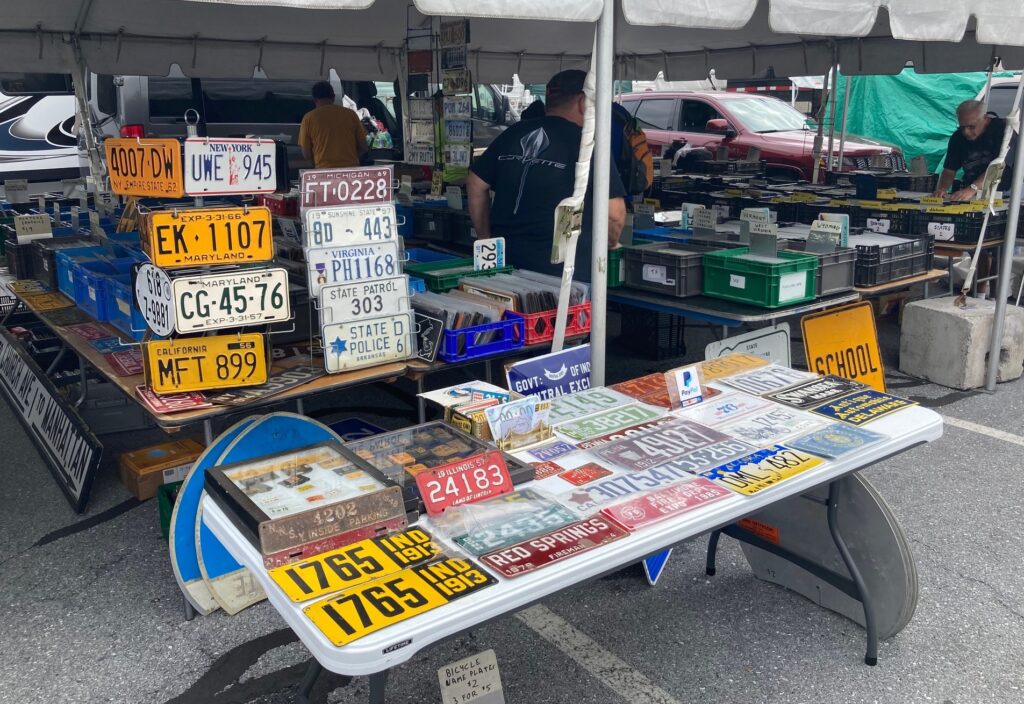
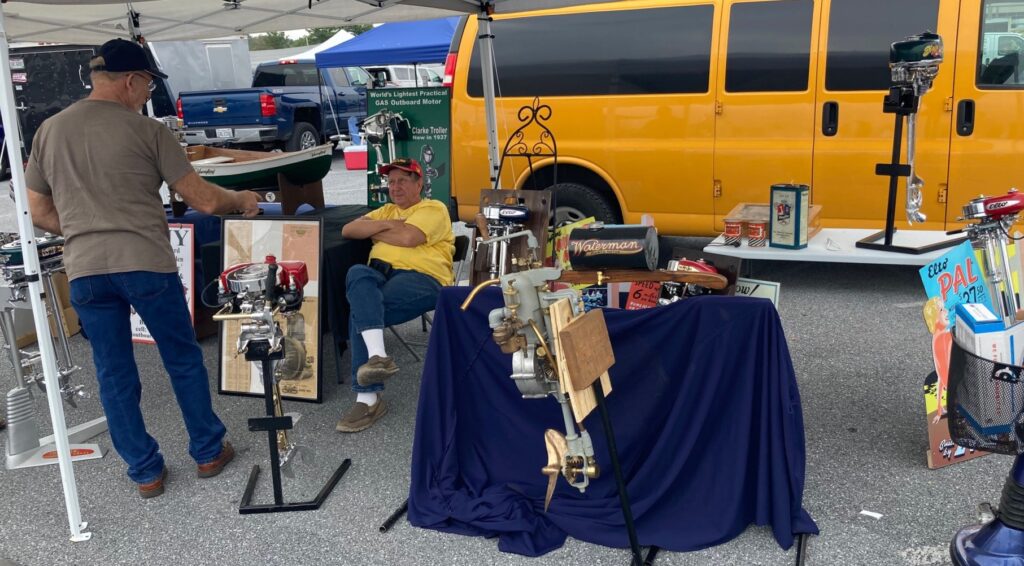
As we know, people collect everything. In the general “automobilia” category, folks put together collections of not only cars, but spark plugs, gas pumps, the globes that go on top of gas pumps, travel maps, gas station advertising … everything pertaining to cars, and other things, just mechanically interesting or from the past. On top we see a vendor catering to vehicle license plate collectors (and car owners wanting plates to match the years of their cars). Below we see a vendor selling antique boat motors; every item has its collector.
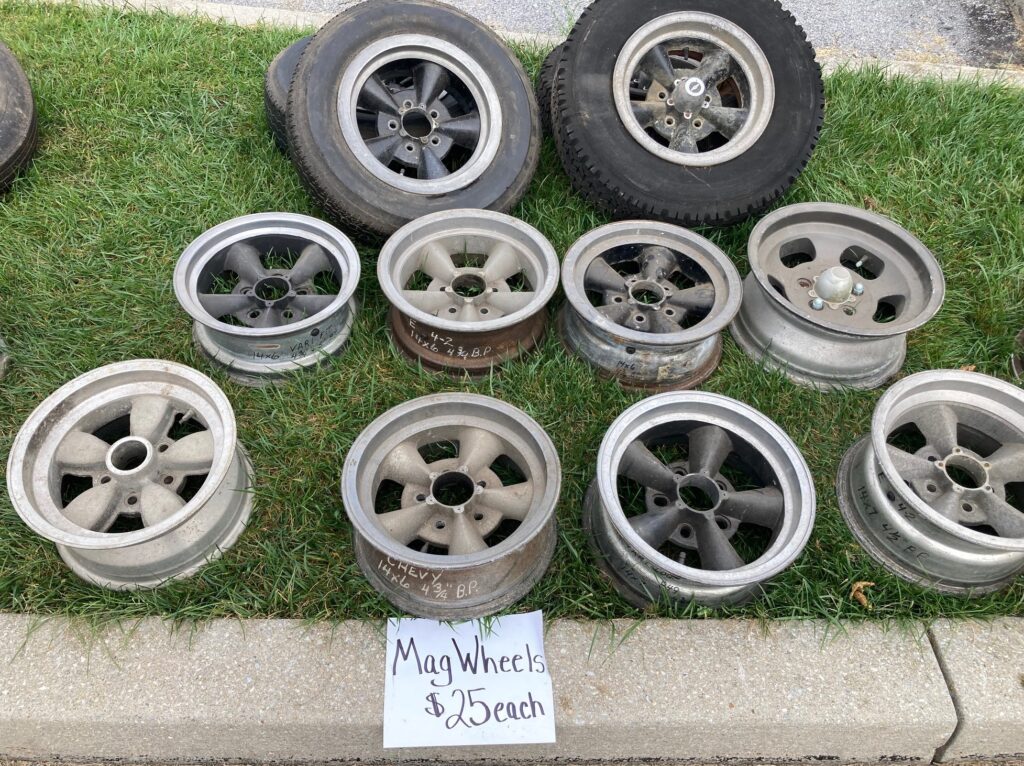
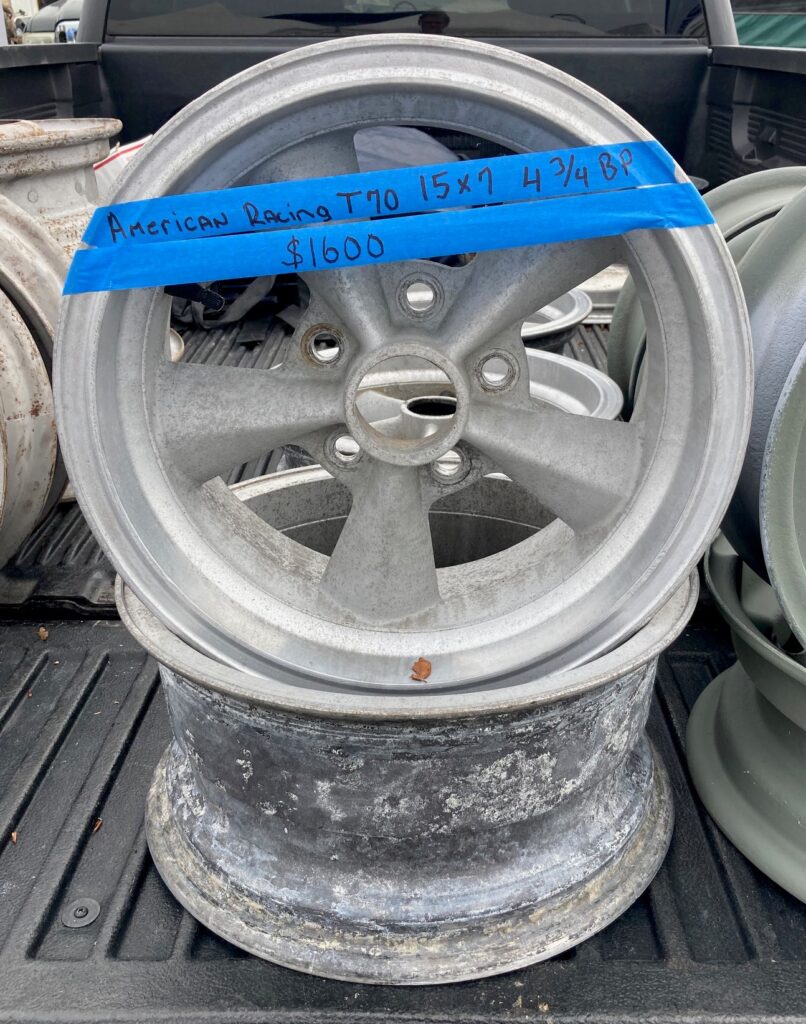
Who doesn’t need a mag wheel to wrap your water- or air-hose on, in the garage? Attractive and practical! The first group are some apparent bargains, at $25 each. Then I saw the set of American Racing mags, displayed about 10 feet from the $25-each vendor’s assortment and priced at $1600. Are they more valuable? Eyes of the beholder?
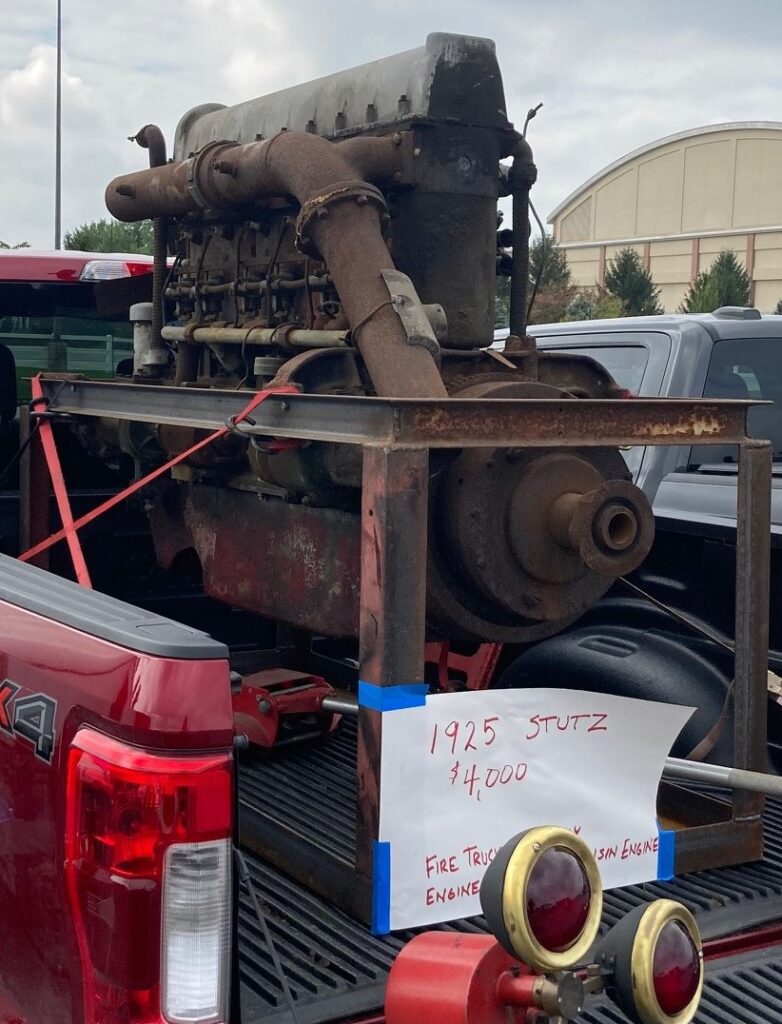
Where else might you run face to face with an immense 1925 Stutz firetruck engine for sale? Be honest–wouldn’t you love disassembling this thing? Something else to contemplate: it’s nearly 100 years old.
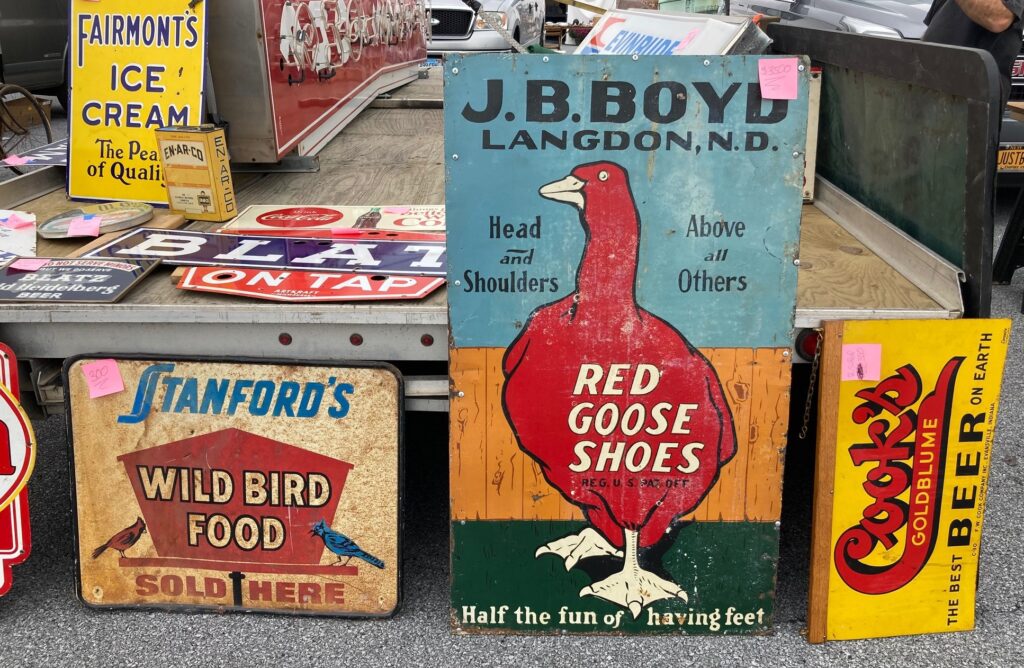
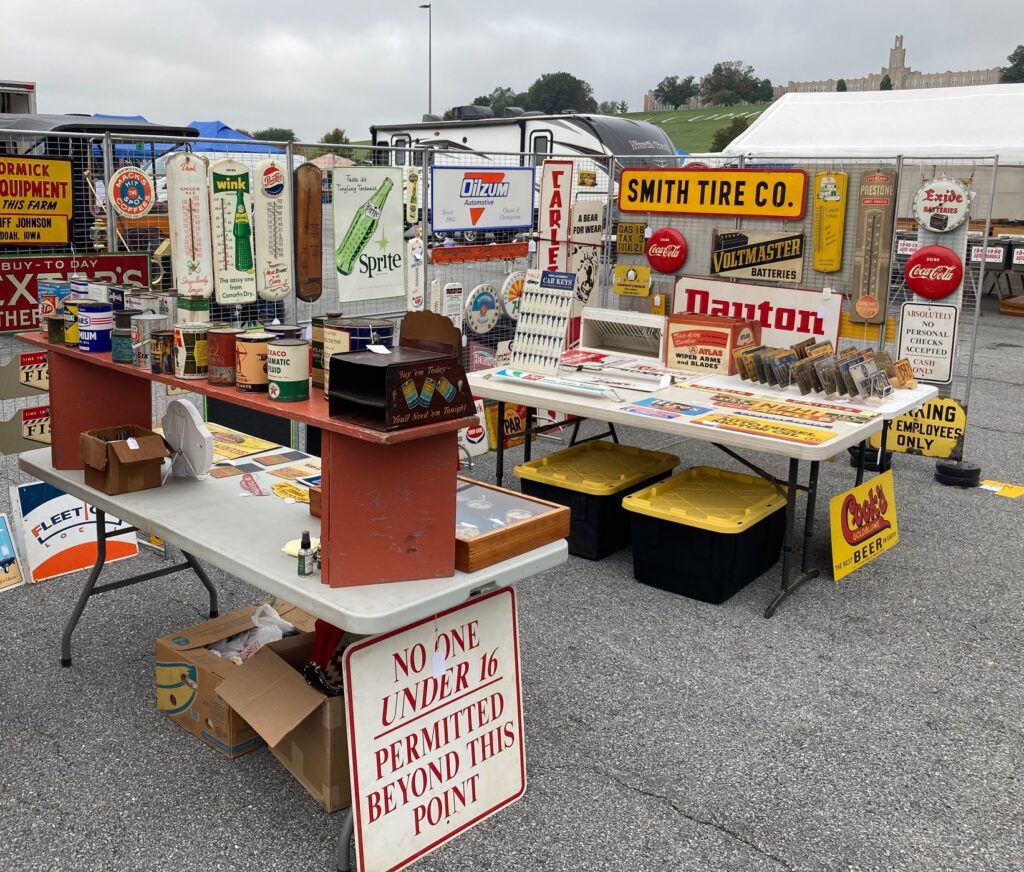
In this American Pickers era, nobody needs to be reminded of the attraction that period enameled signs, particularly, have, not just for dream-garage builders, but all antique fans. What was used to decorate Appleby’s restaurants in the 1980s is now chic and expensive. This is one of those times when us older folks think, “Now, why didn’t I buy a bunch of those old signs when they were just … old signs?!”
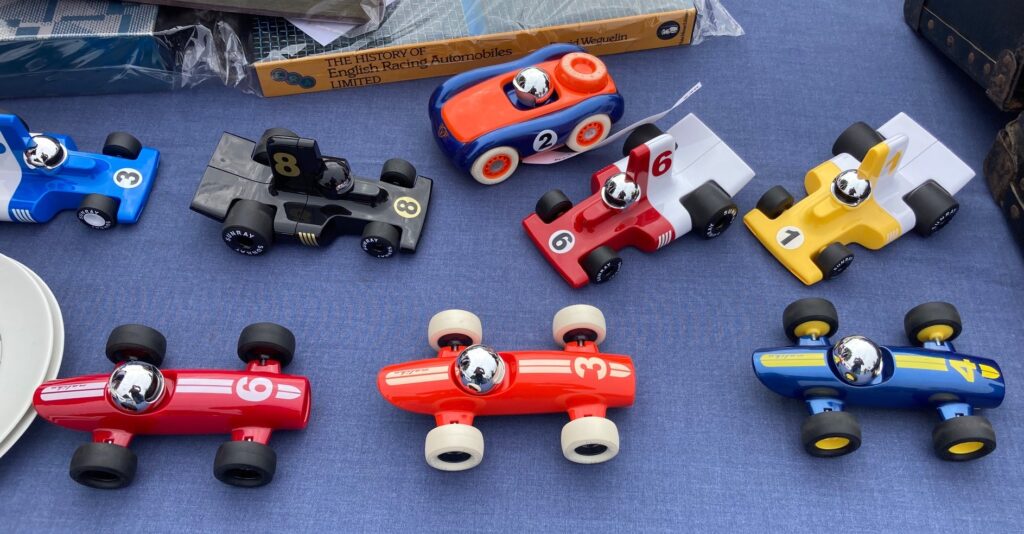
These modern toys are not to be missed! If you handle one, you will have to buy one … or more! Marketed by the Playforever company in the UK (though now made in China), these toys are as indestructible as their name states. Molded from super-high-strength solid plastic with embedded decorations, they also feature soft rubber tires mounted on near-friction-free axles. The overall designs are utterly magnificent aesthetic abstractions of real automobiles; the toy equivalent of a ’55 Bel Air or ’66 Mustang! No matter how many times these cars are bounced off walls and furniture, I can attest that the shiny plastic finish prevails. If you have young kids in your life, you NEED to pick up some of these little guys!
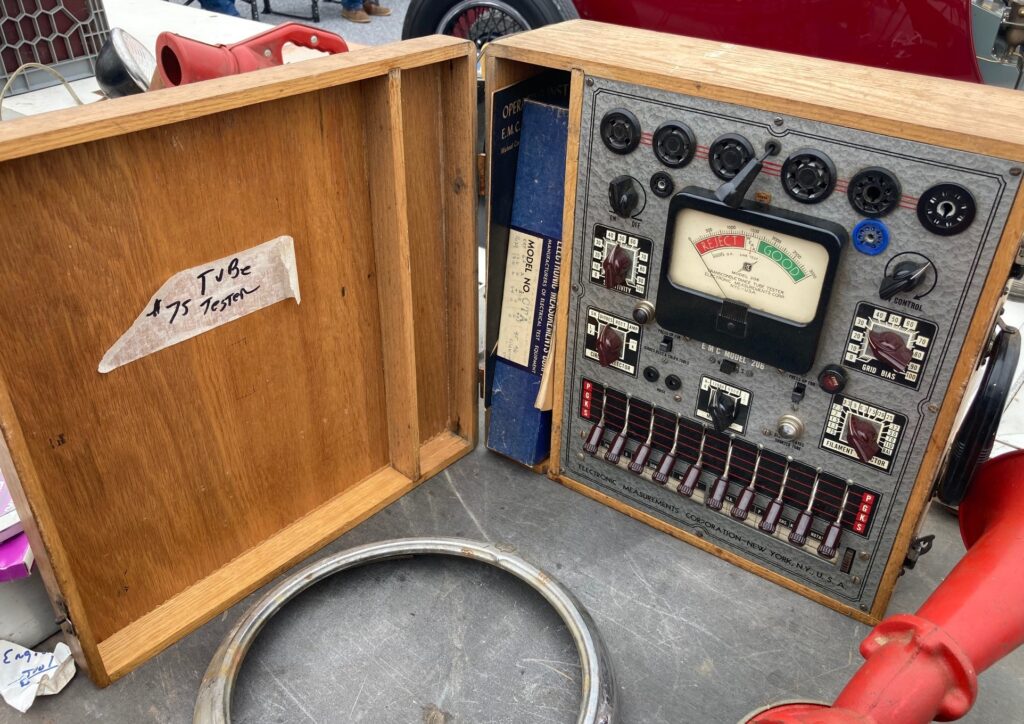
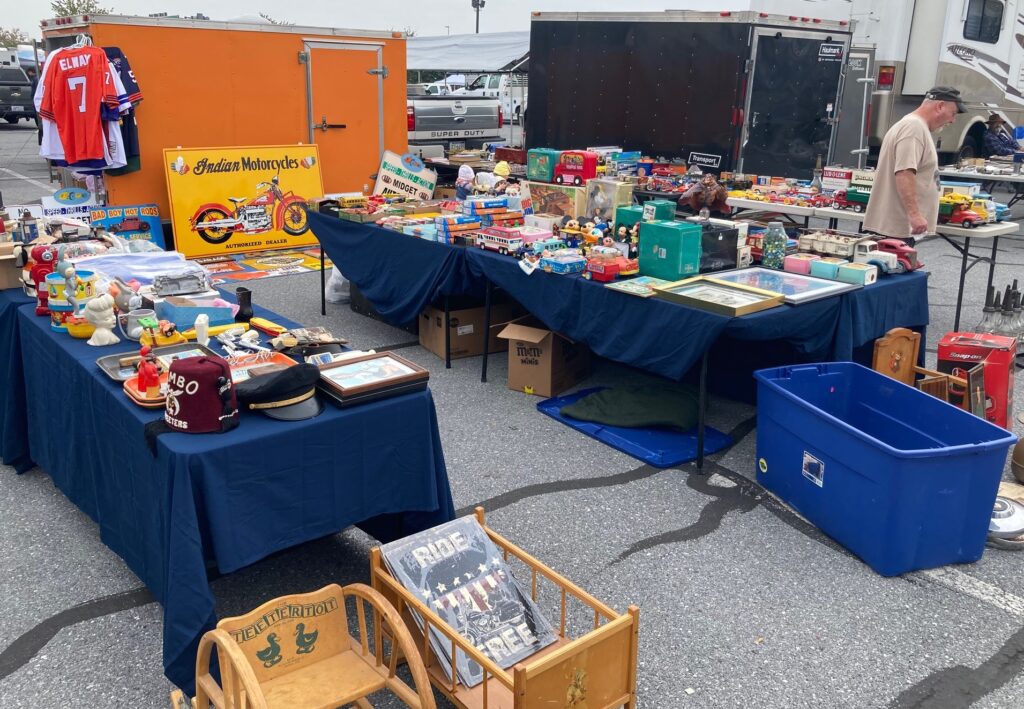
And—everything else. Things you’d forgotten about or, more likely, didn’t know existed! We purchased the wooden-boxed antique tube tester on the left for a negotiated $50, since the seller could guarantee it worked (it did). On the right … do you need a Zembo Shriners fez, old lunch box, 33.3rpm LP, 1950s baby furniture, or sports jerseys? Hershey has you covered.
Final thoughts.
Walking the miles of Fall Hershey and thinking of other days in this same spot, decades before, some differences come to mind. For the good, all of the flea market is now off the grass and onto macadam. Rain will still bring a halt to the fun (since most vendors don’t have tent coverage for their items, but at least, in the event of rain, vendors aren’t hoping for a tractor to extricate them from the fields of goo, and walkers aren’t having their shoes sucked off by the foot-deep mud). The event is wonderfully well-run—and still free for visitors. On a not-as-good and sobering note I saw a troubling percentage of vacant spaces, something almost unheard of, in past years. (Back then, you hoped to get a space!). Fear not, however; the future is more promising than most folks might imagine.
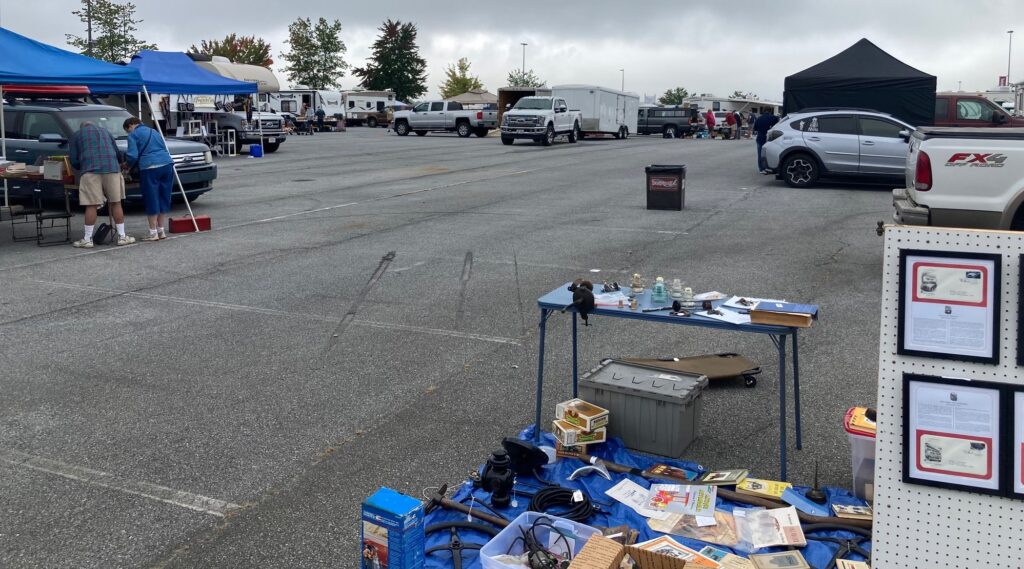
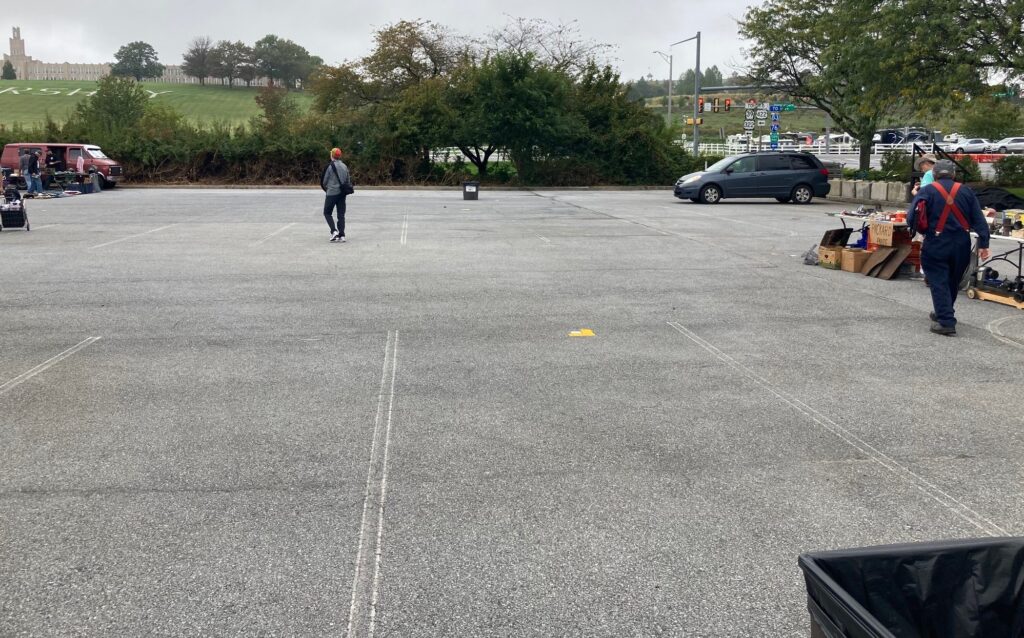
Can you remember the vendors who once filled these spaces? On the right, in the far corner of the upper Red field, was always “Minibike Matt,” displaying a row of rare minis, now moved to Florida.
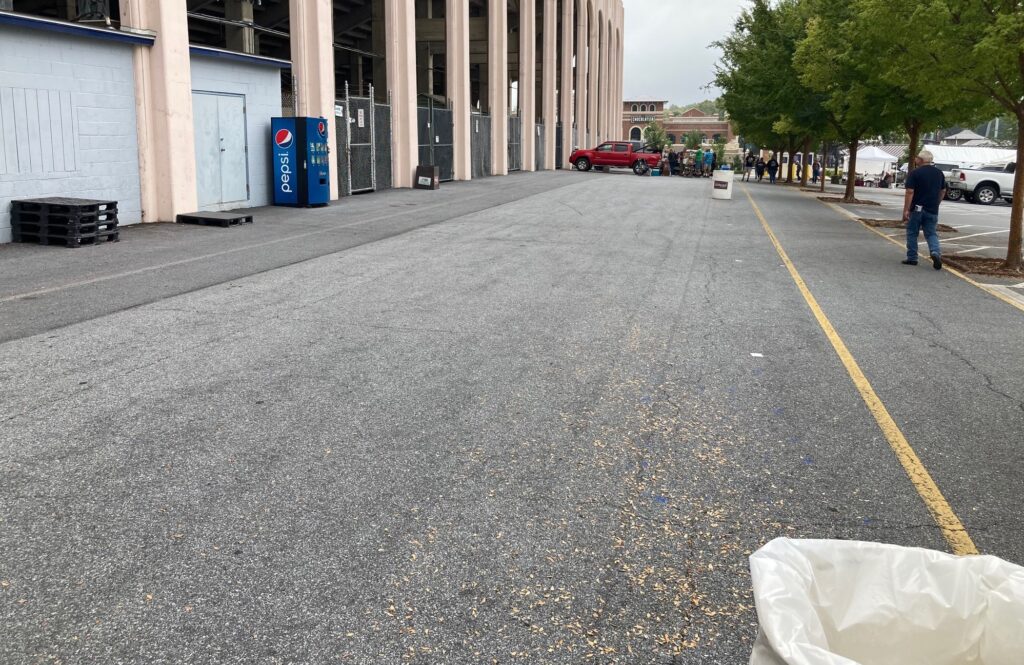
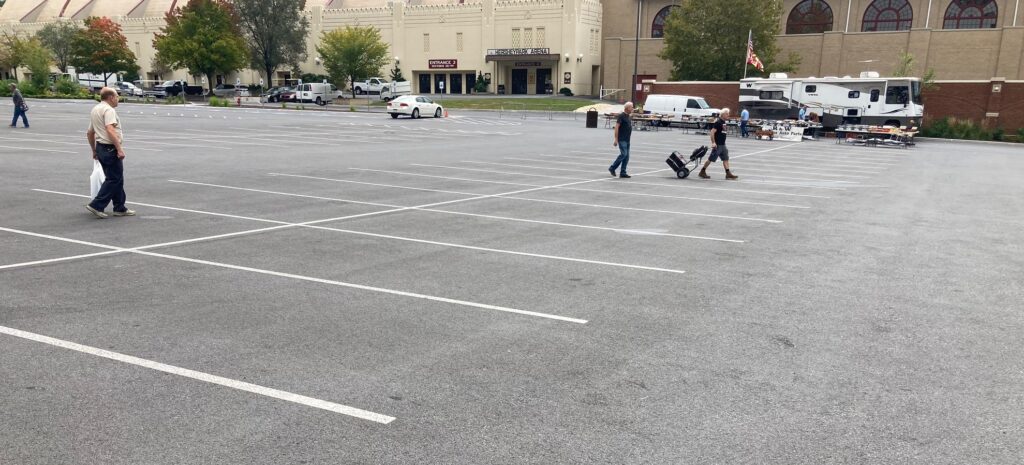
The vendors alongside the stadium had nearly disappeared, and much of the lower Red field was empty. Where have all the folks selling old racing car parts, and the “Craftsman Tool Guy” gone?
Overall, my rough estimate was that the vendor presence in the flea market areas was down by about 15-20%. Perhaps it’s health concerns—or maybe something else is happening, such as a change of interest in Americans. While there are plenty of young people walking the aisles, it would be ridiculous to claim that their number equal those of the old guys, or that old cars aren’t mostly an older person’s game. The AACA and other clubs have been indeed trying to bring in young people for at least twenty years, but ultimately, a natural and innate interest in cars and fixing crude mechanical things and America’s travel history is what is going to bring them. It may just be that a certain cord of interest has been irreparably severed. Nothing lasts forever, it’s said; let’s enjoy the here-and-now while we can.
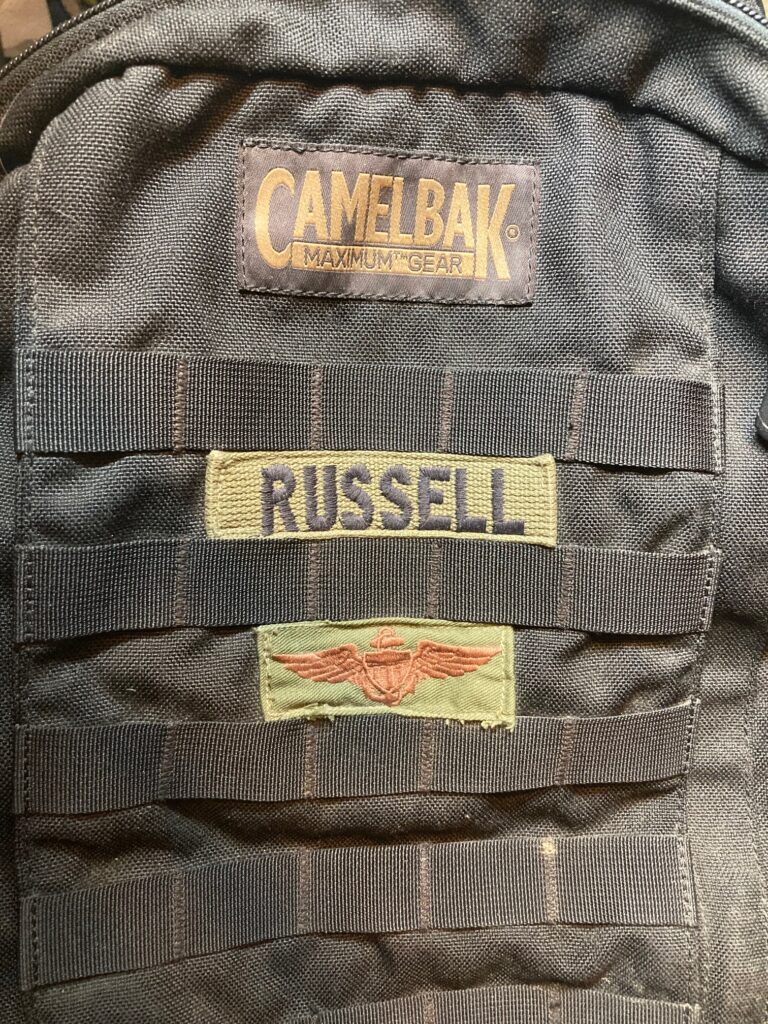
I hope you are all well, and that you’ll be at Hershey in 2022. If you see this backpack, say hello to the guy carrying it!

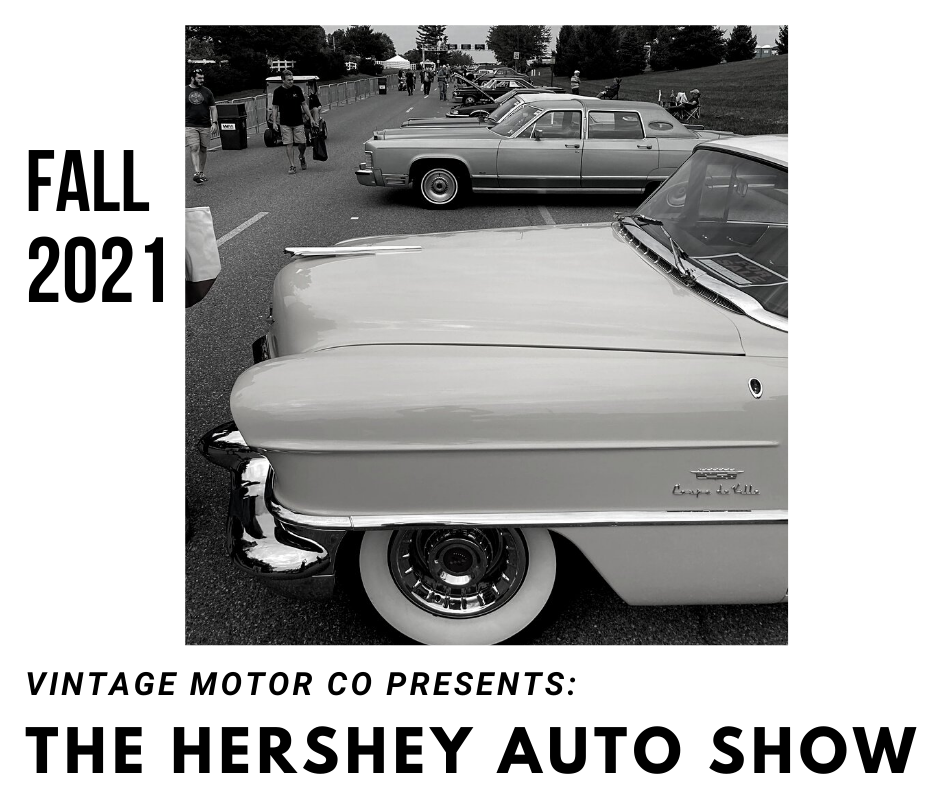
Great history lessons and story telling! You are the master.